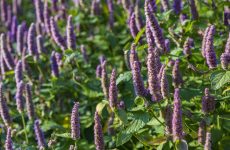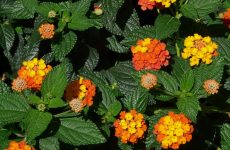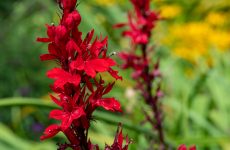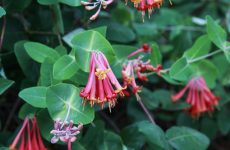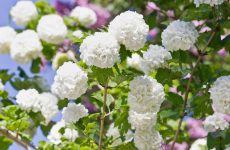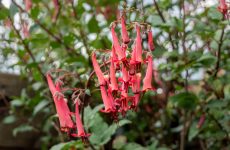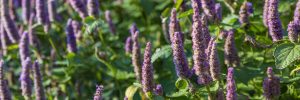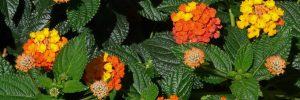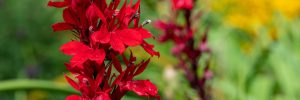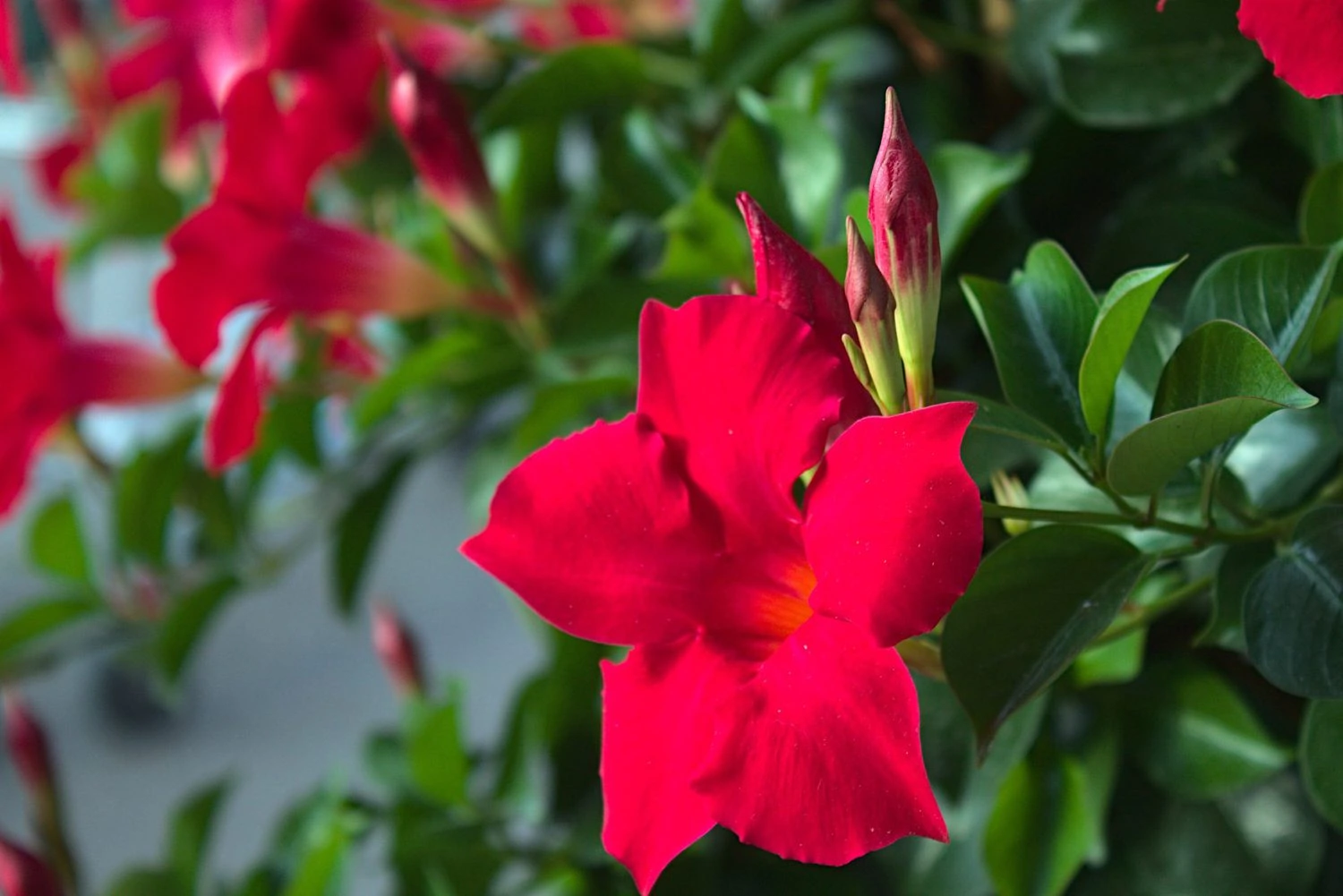
Hummingbirds are famously attracted to red flowers for their nectar that sustains these busy fast flyers. There are loads of red flowers that you can plant in your yard and this list gives you all the information you need to find the perfect plants for you.
Check your plant hardiness zone for your area and then choose the plants from the list that match using the information given below. Also, check which of these hummingbird plants like shade or full sun and choose plants to brighten up any corner of your yard.
These plants may be available in a variety of colors but they all come in red.
So check them all out and get planting.
43 Red Flowers That Attract Hummingbirds
1. Cardinal Flower
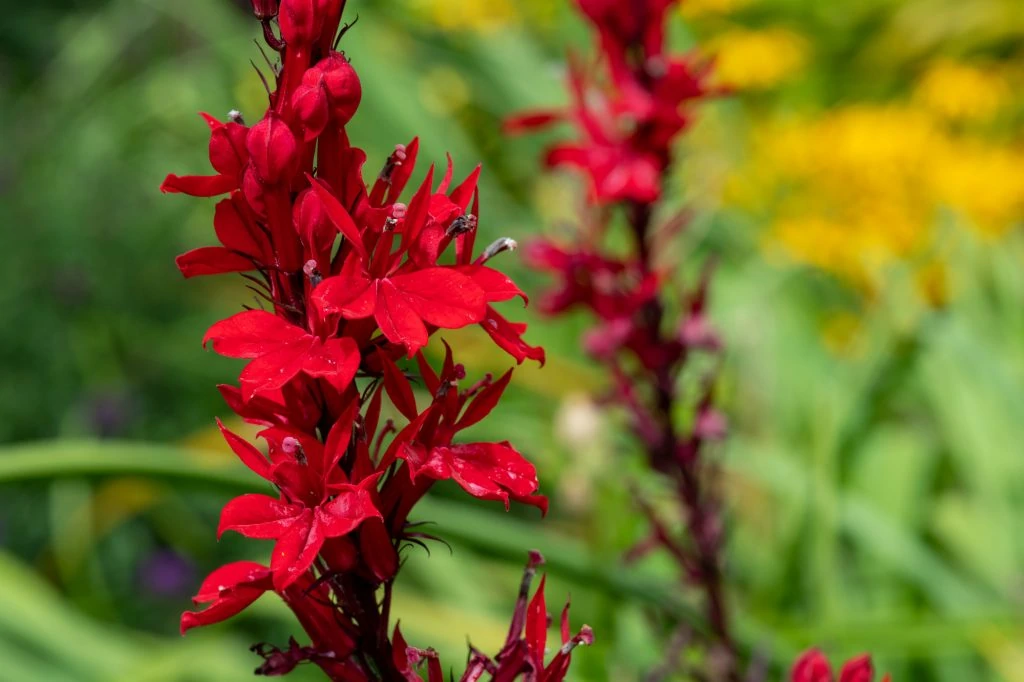
The long bright red tubular flowers of Cardinal flowers are designed for hummingbirds’ long bills. These herbaceous perennials flower in late summer. The bright red flowers appear on terminal spikes.
Cardinal flowers are not drought tolerant and prefer moist soil that does not dry out. When planting cardinal flowers in pots, ensure they are set in a tray of water that can be topped up easily.
- Common Name: Cardinal flower
- Scientific Name: Lobelia cardinalis
- Growing Zones: 3 – 9
- Sun: Full sun to partial shade
- Soil: Rich, moist
- Colors: Red, pink, white
- Height: 2 – 4 feet
- Spread: 1 – 2 feet
- Plant Type: Perennial
2. Impatiens
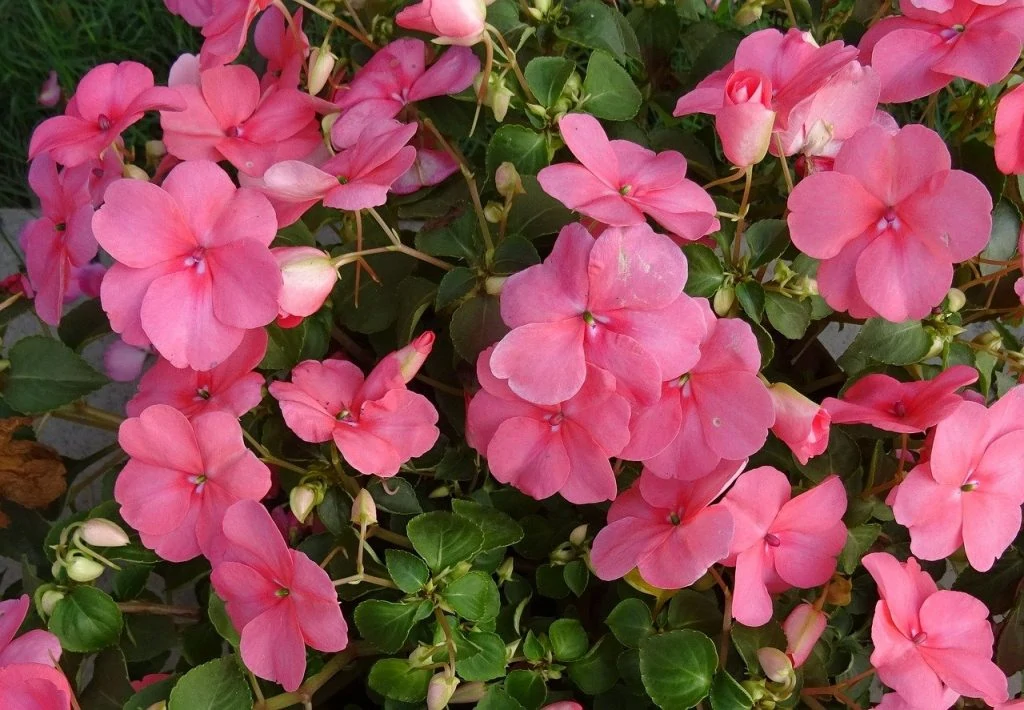
Bright and colorful annuals such as Impatiens are great at brightening up dark and shady areas, and these also attract hummingbirds.
They like moist and well-draining soil and deep shade, so hanging them on your porch will also work well.
Usually grown from plants bought in trays at nurseries and planted close together to create a dense mat of flowers and leaves.
Seeds can be collected from the plants and sown indoors 10 weeks before the last frost as they take a long time to flower. Cuttings can also be taken in the fall and grown indoors until the frost has passed.
- Common Name: impatiens, jewelweed, touch-me-not, snapweed, and patience
- Scientific Name: impatiens
- Growing Zones: 2 – 11
- Sun: Shade or partial shade
- Soil: Rich, well-draining
- Colors: Red, pink, purple, yellow, coral.
- Height: 6 – 36 inches
- Spread: 1 – 3 feet
- Plant Type: Annual
3. Hydrangea
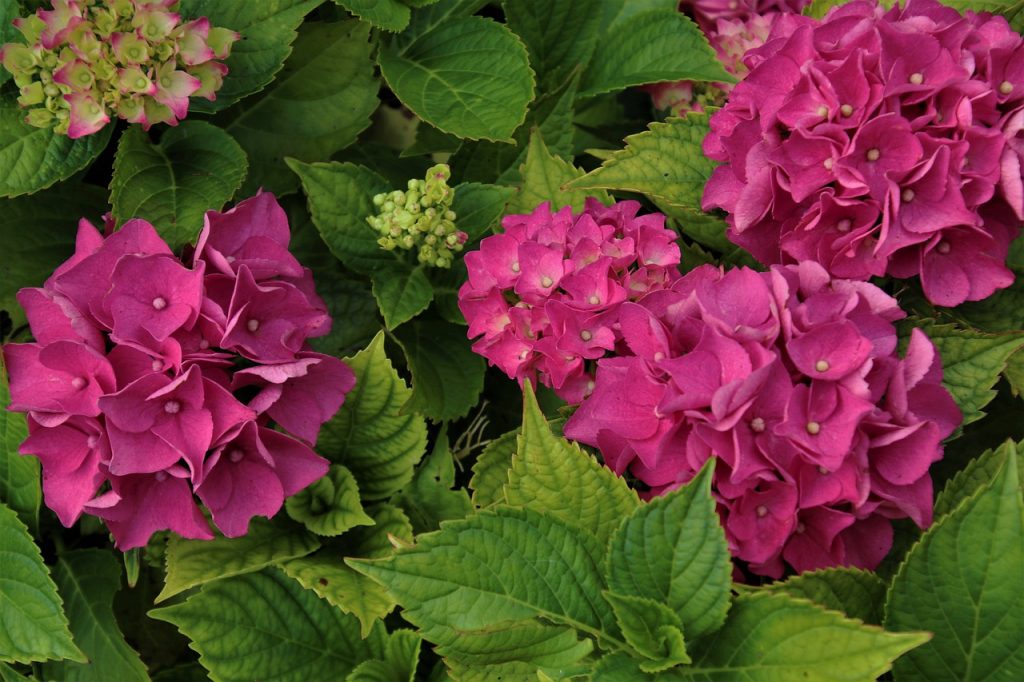
Hydrangeas’ huge flower heads are a wonderful addition to a shady area of your yard. These showy plants do not like it too hot, so shade is the preferred growing condition, especially in the afternoon.
They also like moist soil, so a large water once a week, especially in dry conditions, is needed. Pruning can be done once the flowers have died back in the winter.
Hydrangea flowers keep giving their exuberant display from spring until well into fall before the bloom fades but add interest in winter.
- Common Name: Hydrangea
- Scientific Name: Hydrangea
- Growing Zones: 3 – 9
- Sun: Full sun to shade
- Soil: Fertile, well-draining
- Colors: Pink, Red, White, Blue, Green
- Height: 3 – 15ft
- Spread: 2 – 12 feet
- Plant Type: Perennial
4. Petunias
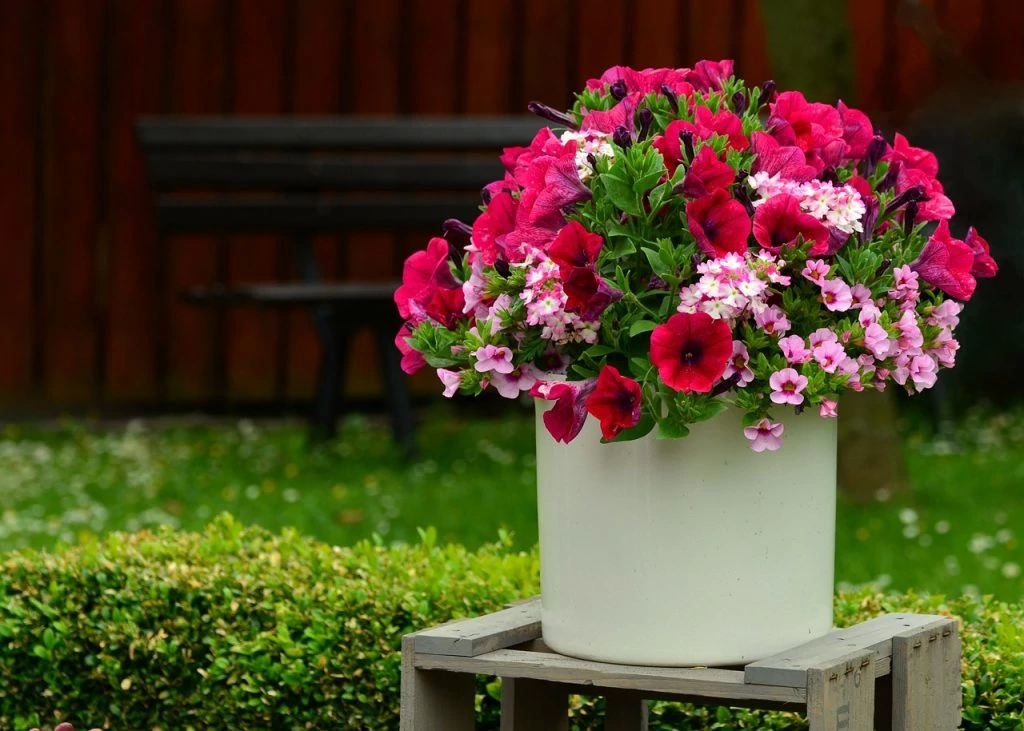
These colorful and inexpensive annuals are easy to grow in a sunny location, and they work great in a container. They create abundant flowers that look great tumbling out of pots and containers.
They are often sold as young plants in flats at a nursery, but you can also grow them from seed. If growing from seed, grow them ten weeks before your last frost date and then plant out once this risk has passed.
Petunias are quite heat-tolerant, but they should get a good soaking about once a week. Prune them to about half the height to prevent them from getting thin and leggy.
Try planting the brighter colors in the reds and pinks for hummingbirds.
- Common Name: Petunias
- Scientific Name: Petunias
- Growing Zones: 9 to 11
- Sun: Full Sun
- Soil: Well-drained moist soil
- Colors: Red, pink, white, blue, purple
- Height: 6 – 18 inches
- Spread: 18 inches to 4 feet
- Plant Type: Tender Perennial, Annual
5. Lantana
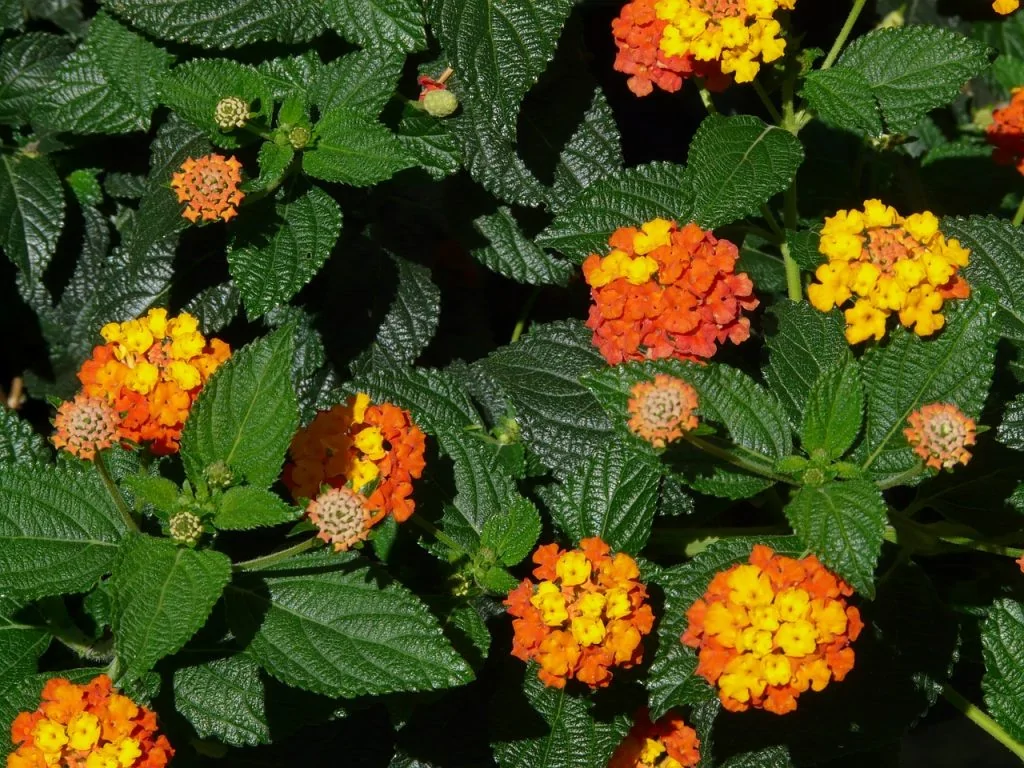
Lantanas are a great way to add interest to pots and containers, and hummingbirds are attracted to their small clustered flowers.
Due to their vine-like growing nature, they look great spilling over pots and baskets.
They can be grown as an annual in colder regions and as an evergreen shrub in frost-free areas.
They are considered invasive in frost-free areas, so check if there are restrictions but growing them in pots will help to stop any spread.
- Common Name: Lantana
- Scientific Name: Lantana
- Growing Zones: 8 – 11 or grow as annual
- Sun: Full sun
- Soil: Well-drained, slightly acid
- Colors: Red, orange, yellow, blue, pink, and white
- Height: 6 feet
- Spread: 6 feet
- Plant Type: Perennial
6. Nasturtiums
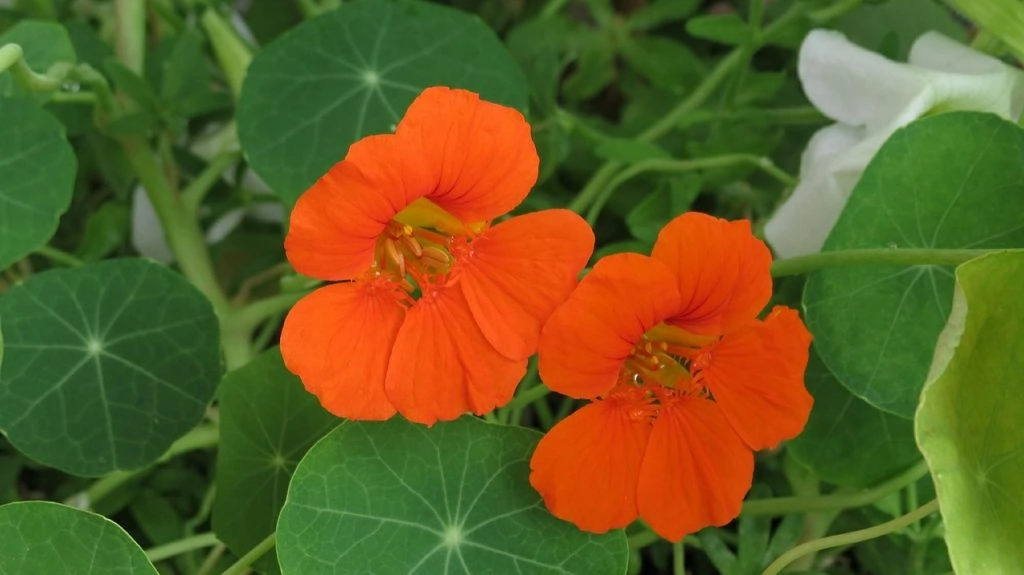
Nasturtiums are trailing edible flowers that are perfect for creating hanging baskets for hummingbirds due to their rich nectar and specially designed deep flowers.
Usually grown as annuals, they come in trailing or bush types. Plant the seeds just after the last frosts outdoors, and they need watering in the growing season and deadheading.
- Common Name: Nasturtiums
- Scientific Name: Tropaeolum
- Growing Zones: 2 – 11
- Sun: Full
- Soil: Well-drained
- Colors: Red, orange, yellow, pink.
- Height: 1 – 10 feet
- Spread: 1 – 3 feet
- Plant Type: Annual
7. Trumpet Honeysuckle
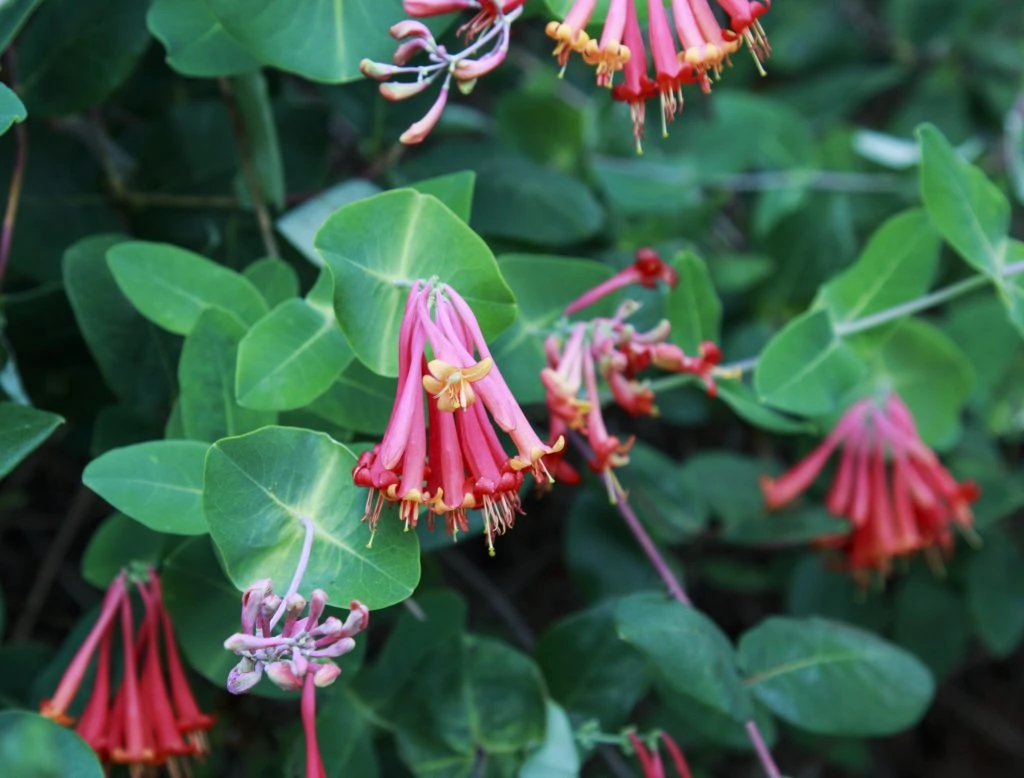
The Trumpet Honeysuckle, Latin name Lonicera sempervirens, is a fast-growing, twining vine from the Caprifoliaceae family, perfect for fences, arbors, or trellises. It may also be left to crawl on the ground, perfect for sprawling on concrete.
Be careful as some honeysuckle is invasive, especially the Japanese honeysuckle (Lonicera japonica), so stick to Trumpet Honeysuckle (Lonicera sempervirens) and check for your area what is invasive.
The Trumpet Honeysuckle is a favorite vine for attracting hummingbirds because of its bright orange-red flowers. When these flowers open, they reveal bright yellow stamens. They grow at the end of the stems in clusters of 10-20 flowers, and they flower from spring to fall. They look especially stunning amid the dark green, oblong leaves.
Aside from its long flowering season, the Trumpet Honeysuckle appreciates being in full sunlight to show off its beautiful flowers. It may still grow in partial shade, but the flowers won’t be as plentiful as when they’re given a full dose of sunlight.
- Common Name: Trumpet Honeysuckle
- Scientific Name: Lonicera sempervirens
- Growing Zones: 4 – 9
- Sun: Full sun, partial shade
- Soil: Medium moisture, organically-rich, well-drained soil
- Colors: orange-red
- Height: 8 – 15 feet
- Spread:3 – 6 feet
- Plant Type: Semi-evergreen, Deciduous, Evergreen Vine, perennial
8. Figwort
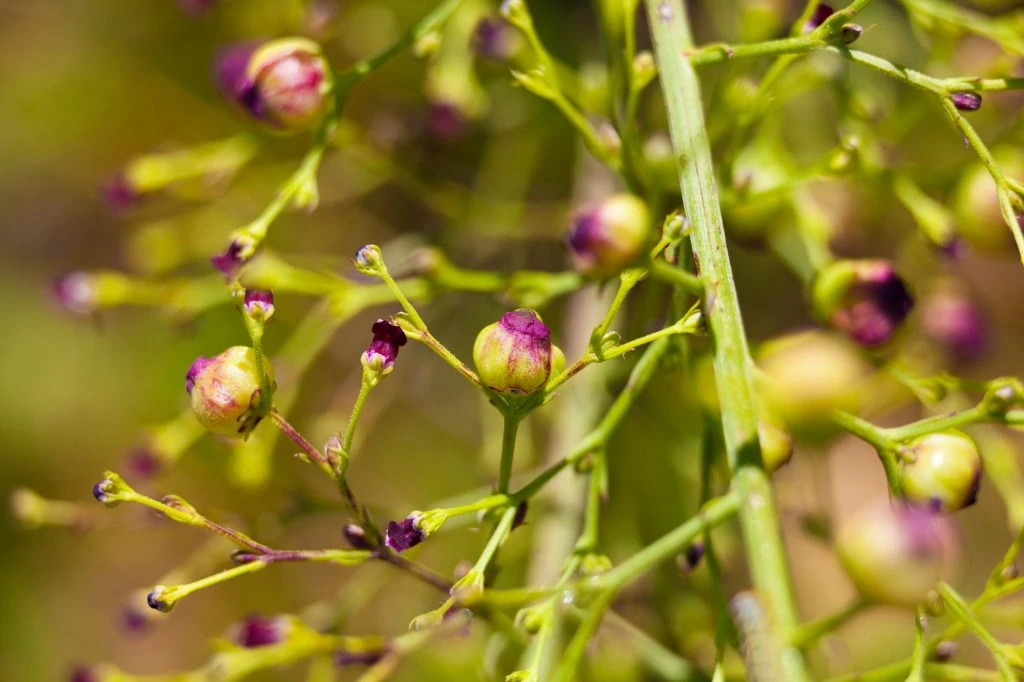
Figwort is the collection of about 200 species of herbaceous flowering plants belonging to the genus Scrophularia. There are 17 figwort species in the United States, and among them, Mimbres Figwort, or Scrophularia macrantha, is pollinated by hummingbirds.
It was originally known as Mimbes Figwort, but nursery growers didn’t think it aptly described the beauty of this plant. So, they named it “Red Birds in a Tree”, because that’s what the flowers resembled. They looked like tiny redbirds on a tree!
Though rare, flower enthusiasts became interested in growing Red Birds in a Tree because they were drought-tolerant, had a long flowering period, and attracted hummingbirds.
The red, two-lipped flowers that grow on the ends of the stems bloom from summer into fall. The tubular shape of the flower, plus its vivid red color, is a surefire way to attract hummingbirds. Since they’re rare, you may want to visit a nursery specializing in rare or unusual plants.
Since it’s native to high plains, it needs full sun to really thrive. It needs regular watering when it’s young, but once it’s established, you won’t need to water it as much. Just don’t overwater it, or the roots will rot.
When they grow, they tend to twine around neighboring plants, so it’s best to pair them with tall and strong plants or provide them with something to support them, like a trellis or an arbor.
- Common Name: Mimbres Figwort
- Scientific Name:
- Growing Zones: 5 – 10
- Sun: Full sun or Morning sun and afternoon shade
- Soil: Any soil type, except clay, with some compost if the soil is poor
- Colors: red
- Height: 3 to 4 feet tall
- Spread:18 inches wide
- Plant Type: Perennial Vine
9. Trumpet Vine
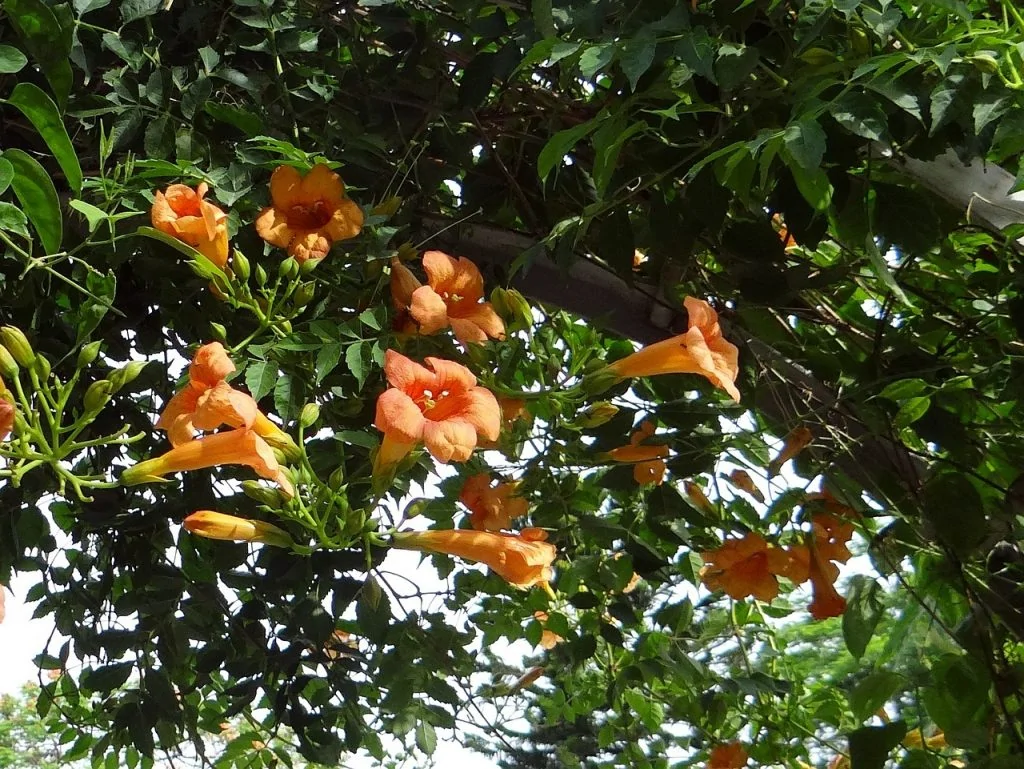
Trumpet vine, Latin name Campsis radicans, is from the family Bignoniaceae and a native of the eastern United States. It is a species of fast-growing and fast-spreading flowering vines, which can become invasive in western states if not controlled effectively through aggressive pruning. Look for hybrids if in western states.
Otherwise known as hummingbird vine, it lives up to its name because the flowers are too attractive for hummingbirds and make them come back repeatedly when they’re in bloom.
Some also call it the Trumpet Creeper because they can creep into crevices and shingles. Some find them valuable for covering rock piles and tree stumps. Their woody stems are strong enough to survive winter, but they’re also capable of destroying foundations, fences, and trees.
The Trumpet Vine is a plant that requires hardly anything to survive. It will thrive under full sunlight, with profuse flowers, when it gets at least 6 hours of direct light. It can also survive in partial shade but with fewer flowers. Regular watering is not necessary. Just keeping the soil moist is fine.
But regular pruning is necessary for the Trumpet Vine to keep it in check and prevent it from spreading too much. The best time is in late fall when you can cut it to nearly ground level. They will grow back sooner than you think, especially with full sunlight.
- Common Name: Trumpet Vine, Trumpet Creeper, Cow Itch
- Scientific Name: Campsis radicans
- Growing Zones: 4 – 9
- Sun: Full sun, partial shade
- Soil: Average, moist but well-drained
- Colors: orange, red, and yellow
- Height: 25 – 40 feet long
- Spread:5 – 10 feet wide
- Plant Type: perennial, Deciduous woody vine
10. Cypress Vine
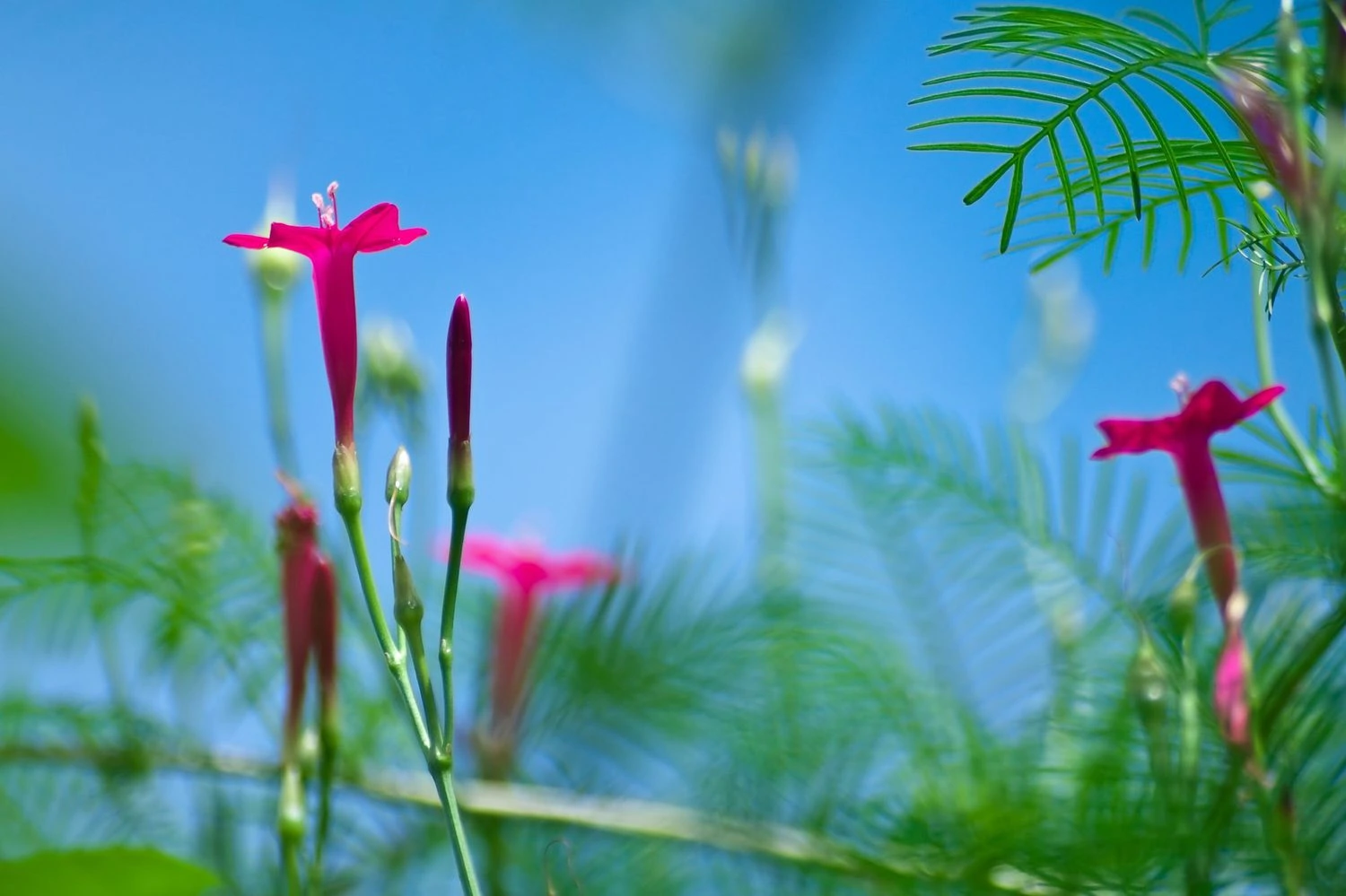
Cypress Vine, Latin name Ipomoea quamoclit, is a member of the bindweed Convolvulaceae family whose origins include tropical South America. It has since been naturalized in other parts of the world, particularly in tropical areas.
The Cypress Vine is cultivated as an ornamental plant that can be a perennial in the tropics but is grown as an annual vine in wintery regions. It looks like a delicate plant with its dainty flowers and fragile-looking leaves, but it is considered an invasive species in some states because it grows fast and can overcrowd other plants and overwhelm nearby structures. Ensure you cut back the plant every year and stop the plant from seeding.
Despite that, it is still one of the best vines for attracting hummingbirds. The Cypress Vine is also called the “Star of Bethlehem” because its flowers are shaped like a star and are also referred to as “hummingbird vine” because their bright red, trumpet-like, nectar-rich flowers are a magnet for hummingbirds.
The red flowers shine beautifully against the Cypress Vine’s thin, thread-like leaves. They grow and spread by twining themselves around structures like arbors, pergolas, chain-link fences, and deck posts that face the sun.
You have to be mindful when growing Cypress Vines because they may overtake other plants when you’re not looking. Instead of moving up, they may grow out, particularly if they latch on to nearby plants.
The trick is to prune them or direct them where you want them to go by carefully wrapping the stems around the support. They do, however, break easily if they lose their support structure.
Another danger to look out for is that all parts of this plant, especially the seeds, are poisonous if eaten by people and pets.
- Common Name: Cypress Vine
- Scientific Name: Ipomoea quamoclit
- Growing Zones: 6 – 11
- Sun: Full sun
- Soil: Fertile, well-drained, and kept evenly moist
- Colors: white, pink, red
- Height: 3 – 20 feet tall
- Spread: climbs to 20 feet
- Plant Type: Perennial vine in tropics, Annual vine in temperate regions
11. Mandevilla

Mandevilla is a group of tropical and subtropical flowering vines from the family Apocynaceae. Mandevilla is also referred to as rocktrumpet, dogbane, or dipladenia, and these plants are native to South America, southwestern United States, and Mexico.
There are many species of Mandevilla, and most of them are climbers with large, showy, fragrant flowers that bloom between late spring to late summer, even up to fall if the weather is mild.
They may have white, pink, and red flowers that look great against fences, trellises, and arbors. The tube-shaped structure of the flowers, plus their bright colors, make them attractive to hummingbirds and other pollinators.
Mandevilla can be grown in pots on the ground or in hanging gardens. They may also be planted directly onto soil with a support structure for them to climb and twine around. They prefer full sunlight, moist soil unless the climate has turned colder, where you have to water them less to keep their roots from rotting.
Another thing to do with Mandevilla to keep them growing and flowering is to re-pot them every year. A good change of soil and pot to accommodate for new growth is essential to keeping Mandevilla healthy. Just be mindful during the process, as Mandevilla is considered toxic. Their milky sap can irritate the skin upon contact, and while they’re not totally poisonous, pets may have a reaction when they ingest any part of the plant.
- Common Name: Mandevilla, rocktrumpet, dogbane or dipladenia
- Scientific Name: Mandevilla
- Growing Zones: 9 – 11
- Sun: Full Sun, partial shade
- Soil: Moist but well-drained
- Colors: white, pink, red
- Height: 3 – 10 feet tall
- Spread: 3 – 4 feet wide
- Plant Type: Perennial vine, an annual vine in colder climates
12. Passionflower
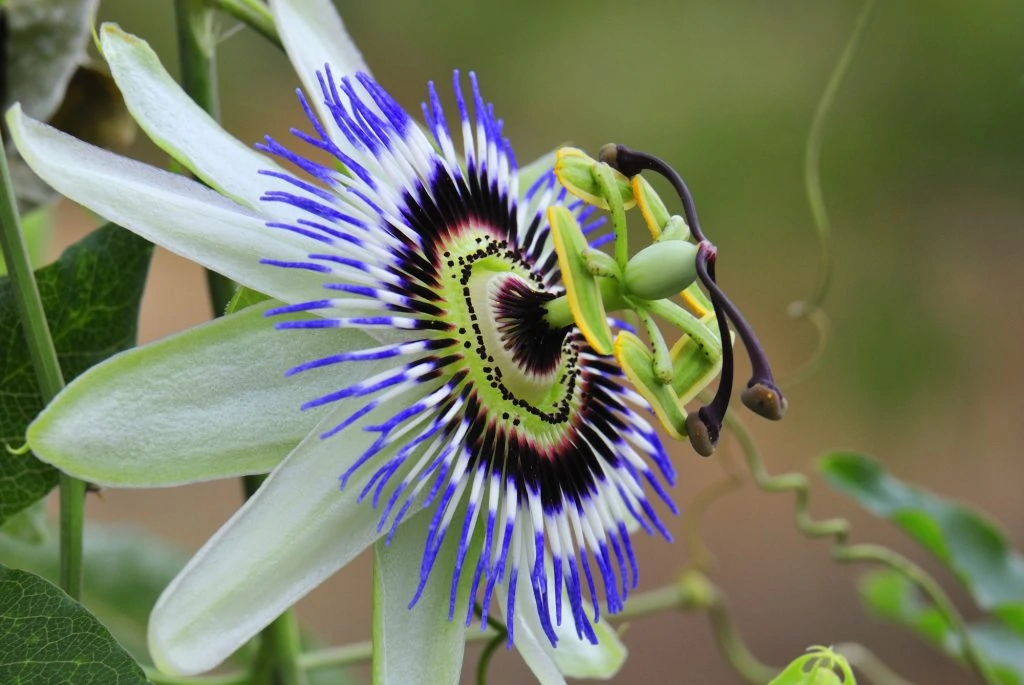
Passionflowers, or passion vines as they’re sometimes called, belong to the Passiflora genus with about 550 species of flowering plants. They’re characterized by having tendril vines and an exotic-looking floral structure that attracts pollinators like bees and hummingbirds. In fact, the Sword-billed Hummingbird evolved with the Passiflora mixta in order to extract nectar from its long corollas.
Passionflowers are unforgettable because they look exotic and alien. They are named passion flowers because their strange structure supposedly symbolizes the Passion of Christ.
Passionflowers are truly unusual creations that will look astounding in a pot or on trellises, walls, and fences. They have a variety of colors (white, pink, red, purple, blue) that thrive under full sunlight or at least 4 hours of it. Moist, well-drained organic soil also helps them grow fast and tall.
When a hummingbird successfully pollinates the flower, the fruit will start growing. The fruits are round or elongated, and depending on the variety of the passionflower they are edible. One passionflower, Passiflora incarnata, is commonly known as “Maypop” because it’s the sound of the fruit popping when crushed.
- Common Name: passionflower maypop, true passionflower, wild apricot, wild passion vine, passion vine
- Scientific Name: Passiflora
- Growing Zones: 5 – 9
- Sun: Full sun (at least 4 hours)
- Soil: well-drained, organic soil
- Colors: white, pink, red, purple, blue
- Height: 6 – 30 feet tall
- Spread:3 – 6 feet wide
- Plant Type: Perennial vine
13. Rhododendron
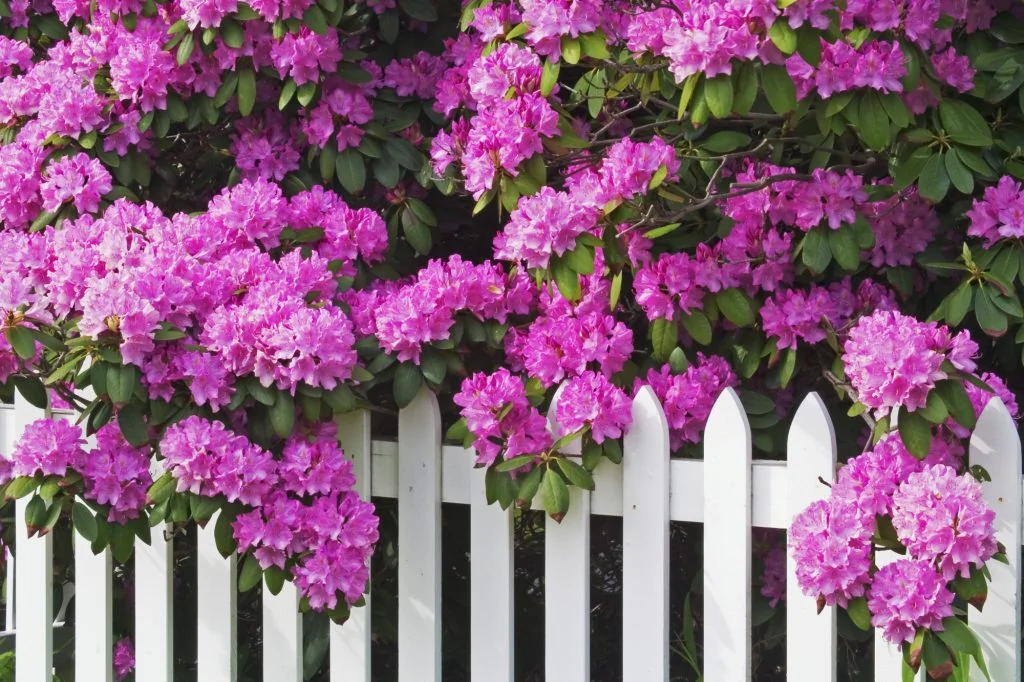
Rhododendrons are a large group of woody plants belonging to the heather family, Ericaceae. There are about 1,000 species of rhododendrons ranging from tiny shrubs to large trees. These evergreen shrubs are often used in ornamental landscaping because most hardy plants lose their leaves or die from the frost. They also have bright and colorful flowers.
It is easy to differentiate rhododendrons from azaleas, their most similar species. Most rhododendrons have bell-shaped, colorful flowers with ten stamens, while azaleas have one funnel-shaped flower with five stamens per stem. Rhododendrons have many flowers per stem, azaleas only have one, but since there are many stems to a shrub, this difference is hard to see.
With many varieties of rhododendrons, it is possible to plant and cultivate them all year long, especially if you have mild climates. However, early spring planting is your best choice when you live in an area with cold temperatures.
When you have hotter weather, early fall is the right time. Rhododendrons thrive better in environments that are not too hot and not too cold. You have to give them time to acclimate to the temperatures when you plant them.
Soil preparation for rhododendrons is important. You have to keep soil acidity between a pH of 4.5 – 5.5. Do a soil test to make sure. If the pH is too high, apply a small amount of agricultural sulfur or iron sulfate. However, if the pH is too low, apply ground limestone.
Allow rhododendrons to receive 6 hours of full sunlight when you live in colder climates (Zones 4-6) but give them ample shade when you live in hotter regions (Zones 7-11). Make sure they have well-irrigated soil and avoid getting the roots soaked in water.
Hummingbirds are attracted to rhododendrons because they have a variety of colors like pink, purple, red, white, and yellow.
- Common Name: Rhododendron
- Scientific Name: Rhododendron
- Growing Zones: 4 – 11
- Sun: Partial shade
- Soil: Well-drained, Acidic
- Colors: Pink, Purple, Red, White, and Yellow
- Height: 18 inches to 50 feet
- Spread: 2 – 3 feet
- Plant Type: Perennial
14. Hibiscus
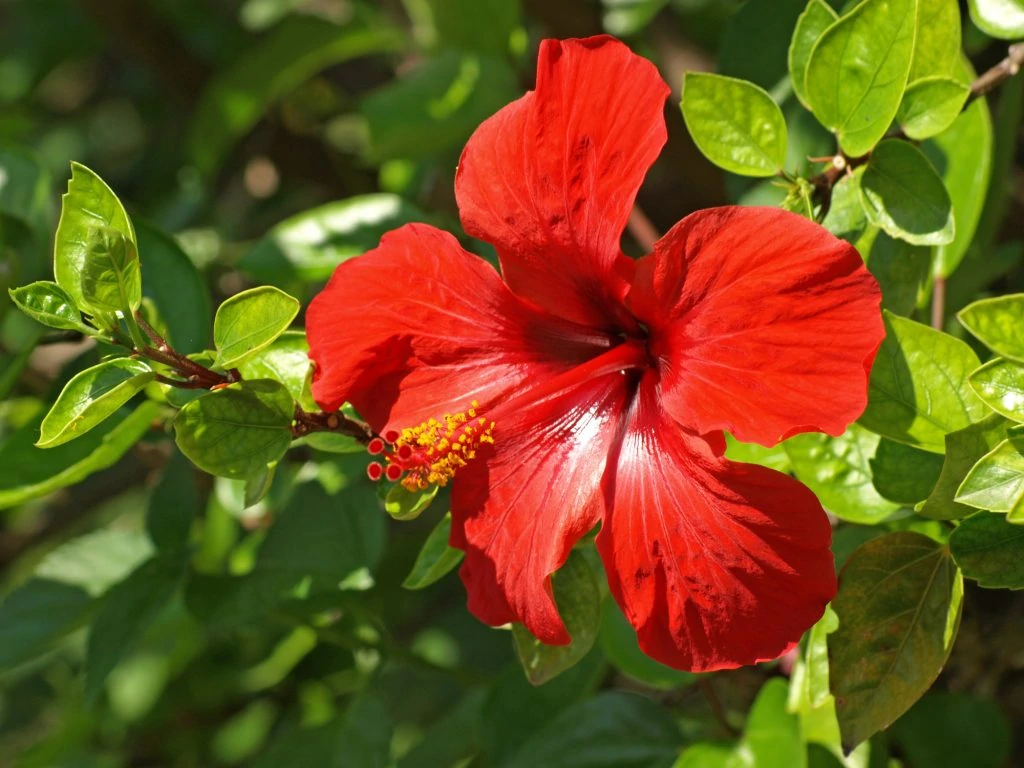
Hibiscus plants are from the mallow family, Malvaceae, and there are hundreds of varieties, including perennials and evergreens. Some perennials, like the Hibiscus coccineus, can grow in Zones 6 to 9, while some evergreens, like the Hibiscus rosa-sinensis, can grow year-round in Zones 9 and 10.
Hibiscus plants are characterized by large, trumpet-like flowers that may be colored red, yellow, pink, orange, and white. They may have five or more petals, and some single-bloom varieties flower for only one to three days. However, some tropical hibiscus species can repeatedly flower during their season.
Most Hibiscus plants start to flower from mid to late spring or mid to late summer, depending on the region. Some have also been known to flower until fall, but that may only be possible if the climate is mild.
If you want your hibiscus plants to flower, make sure they receive up to 6 hours of full sunlight daily. Watering your hibiscus depends on the weather. If it’s too hot, give it water daily. If it’s average, a couple of times a week will be enough, as long as the soil is moist. If it gets cold, hold off on watering until the soil is dry, and make sure to keep the plant indoors because they don’t really tolerate cold weather.
Hibiscus plants are a sight to behold when they’re in full bloom, and it’s understandable why they can attract hummingbirds. Taking care of your hibiscus will keep hummingbirds coming to your backyard for sure.
- Common Name: Hibiscus
- Scientific Name: Hibiscus
- Growing Zones: 6 – 10
- Sun: Full Sun
- Soil: Well-drained,
- Colors: Red, Yellow, Pink, Orange, and White
- Height: 3 – 8 feet
- Spread: 3 – 5 feet
- Plant Type: Perennial, Evergreen
15. Native Buddleia – Butterfly Bush
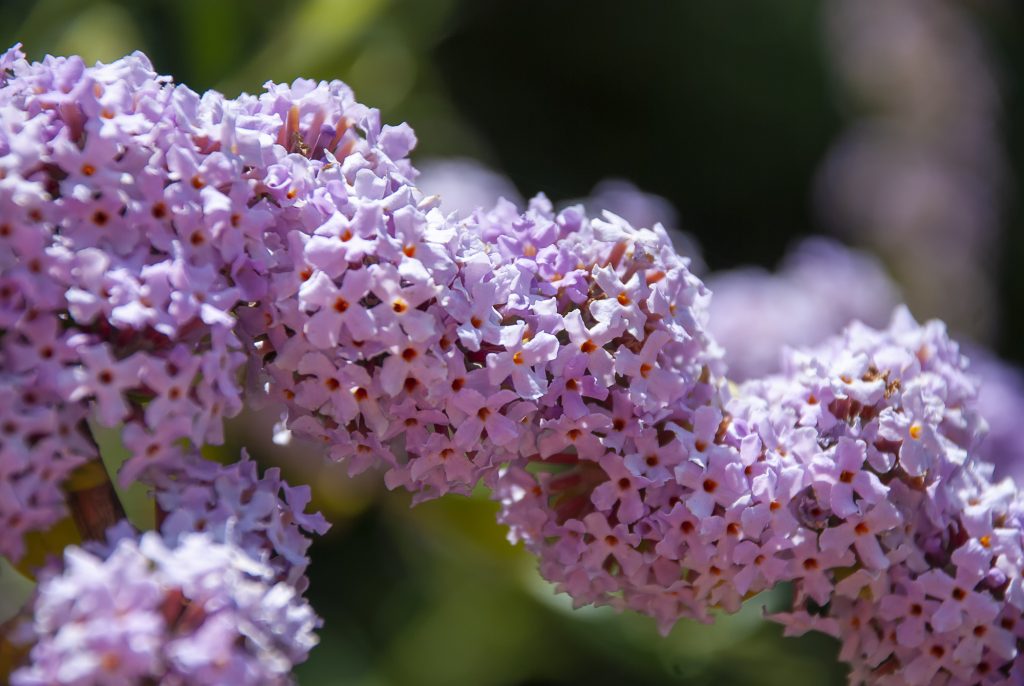
Buddleia or Butterfly Bush, with its striking purple, red, pink, white, and yellow pointed flowers, is a favorite ornamental plant if you want to attract butterflies (of course!) and hummingbirds to your backyard. They also produce nectar-rich flowers that are a surefire way to get hummingbirds to visit your backyard every time.
Buddleia refers to a family of over 140 species of flowering plants. They are more commonly called “butterfly bushes” because butterflies flock to them because of their nectar and honey-scented flowers.
The most common Buddleia variant is the Buddleia davidii which originates from China. Unfortunately, this species has been declared an invasive species in most US regions because it spreads its seeds and can grow unrestrained in natural areas. They tend to overcrowd native plants and have been deemed as a noxious weed. Be careful not to buy the purple davidii variety.
Butterfly bushes are low-maintenance plants. They are a hardy breed requiring full sun, so you might say they are pretty much drought-tolerant. However, during the first year, they would require regular watering as they’re trying to establish their roots. But once they’re firmly established, you only need to water them when the soil has become dry, like 2 to 4 inches deep.
The good news is, there are some Butterfly Bush variants that are sterile, and some species are available to grow in your pot or backyard, like Dwarf varieties that only grow up to 8 or 10 feet.
Some sterile or native varieties that you can grow are Rio Grande Butterfly Bush (Buddleia sessiliflora), Wand Butterfly Bush (Buddleia racemosa), Escobilla Butterfly Bush (Buddleia scordioides), and Fountain Butterfly Bush (Buddleja alternifolia).
- Common Name: buddleia, butterfly bush, and summer lilac
- Scientific Name: Buddleja
- Growing Zones: 5 – 10
- Sun: Full Sun
- Soil: Well-drained
- Colors: Pink, Purple, Red, White, and Yellow
- Height: 4 to 10 feet
- Spread: up to 5 feet
- Plant Type: Perennials, Evergreen
16. Cape Myrtle
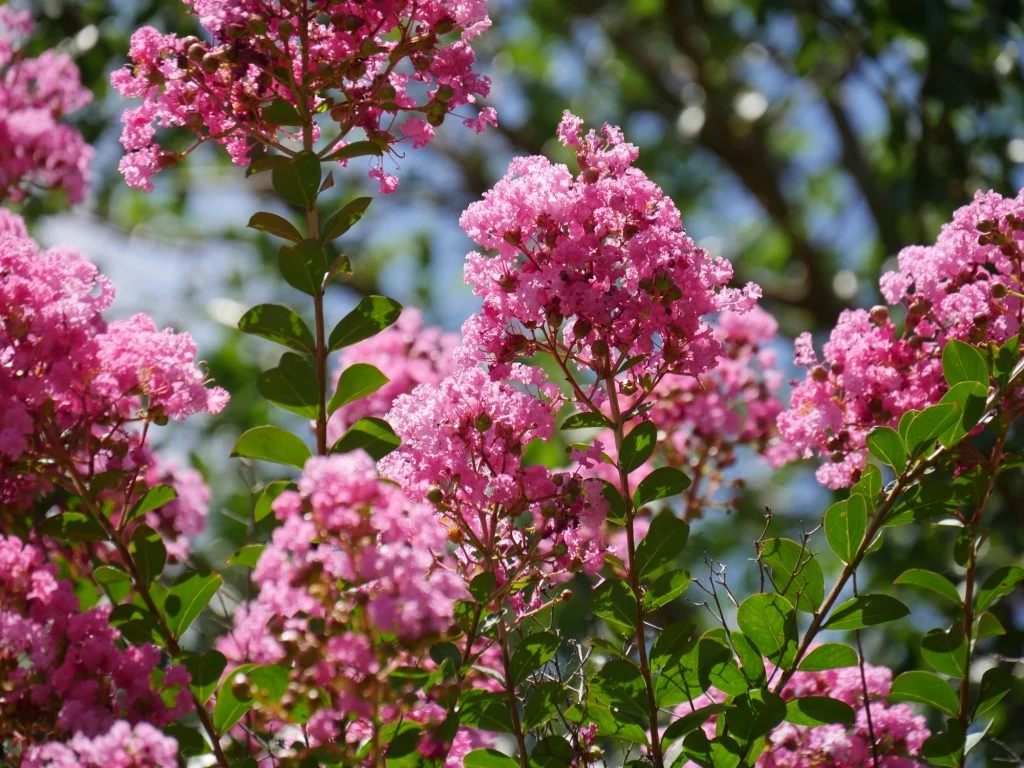
Crape Myrtle, or crepe myrtle, with the Latin name Lagerstroemia, belongs to the Lythraceae family. They are deciduous and evergreen shrubs originally from India, Asia, and Australia. They are sometimes called crepe myrtle because their flower petals have a crepe-like texture.
These Crape Myrtle trees or shrubs are brilliant additions to backyards because of their bright, large flowers, peeling bark in winter, and foliage that changes color in the fall. There are many varieties to grow, from single to multi-stemmed trees, smaller shrubs, and even dwarf trees as small as 2 to 5 feet tall.
Like most deciduous trees and shrubs, it’s best to plant them during fall or early spring to get their roots adjusted before the cold of winter or the heat of summer hits. They need at least 6 hours of full sunlight to encourage large, full blooms. They flower in mid-May and early June.
To ensure that your Crape Myrtle tree flower profusely, it is essential that you prune old and dead branches carefully. Give the new plants room to grow, so remove crisscrossing branches, short twigs, and branches that grow toward the center. Shrubs hardly need pruning except maybe to remove old and dead branches.
With their bright-colored flowers and a varying range of height, it’s easy to see why hummingbirds and butterflies love hanging around Crape Myrtles.
- Common Name: Crape Myrtle or crepe myrtle
- Scientific Name: Lagerstroemia
- Growing Zones: 7 – 10
- Sun: Full sun
- Soil: Moist soil
- Colors: dark purple, dark red, bright pink, magenta, and white
- Height: trees 15 – 20 feet, shrubs 5 – 7 feet
- Spread:trees 15 – 20 feet, shrubs 5 – 7 feet
- Plant Type: Perennial, Deciduous shrubs or trees
17. Agastache
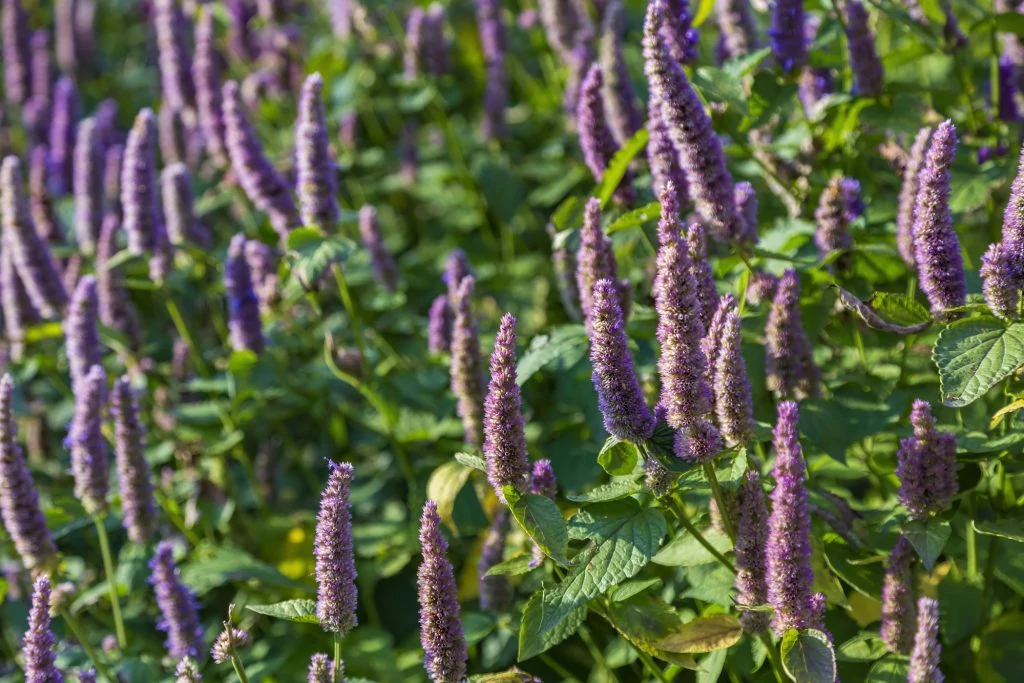
Agastache, pronounced as (“ah-GAH-stuh-kee”), are aromatic herbaceous perennials with as many as 22 species, most of which are native to North America. They are commonly referred to as “hummingbird mints” and “Giant hyssops”. Aside from being a hummingbird magnet, they can also be made into herbal tea.
Agastache flowers are attractive to hummingbirds because they literally stand out from among the leaves. They are about 3 to 4 inches long and appear fuzzy because they’re made of many tiny flowers growing in clusters. Their striking purple and red colors are a hummingbird’s favorite colors, and they will be unable to resist flocking to Agastache flowers, especially when they’re in full bloom in the summer.
The best way to grow Agastache flowers is to start them as indoor plants in May and then transplant them into flower beds in the summer. They require full sun and regular watering when they’re still trying to establish themselves. However, once they’re done, they are drought-tolerant and can easily be left to their own devices.
Agastache are desert plants, hence they can tolerate even the hottest days. That is also the reason why it’s not necessary to keep watering them once they’re established. Too much water will rot the roots, so make sure to just give them a good splash and then leave them alone to dry.
- Common Name: Agastache, Hummingbird Mint, and Hyssop
- Scientific Name: Agastache
- Growing Zones: 3 – 10
- Sun: Full Sun
- Soil: Lean soil, well-drained
- Colors: Blue, purple, red, orange, pink, and white
- Height: 3 to 5 feet tall
- Spread:
- Plant Type: Herbaceous perennial
18. Salvia
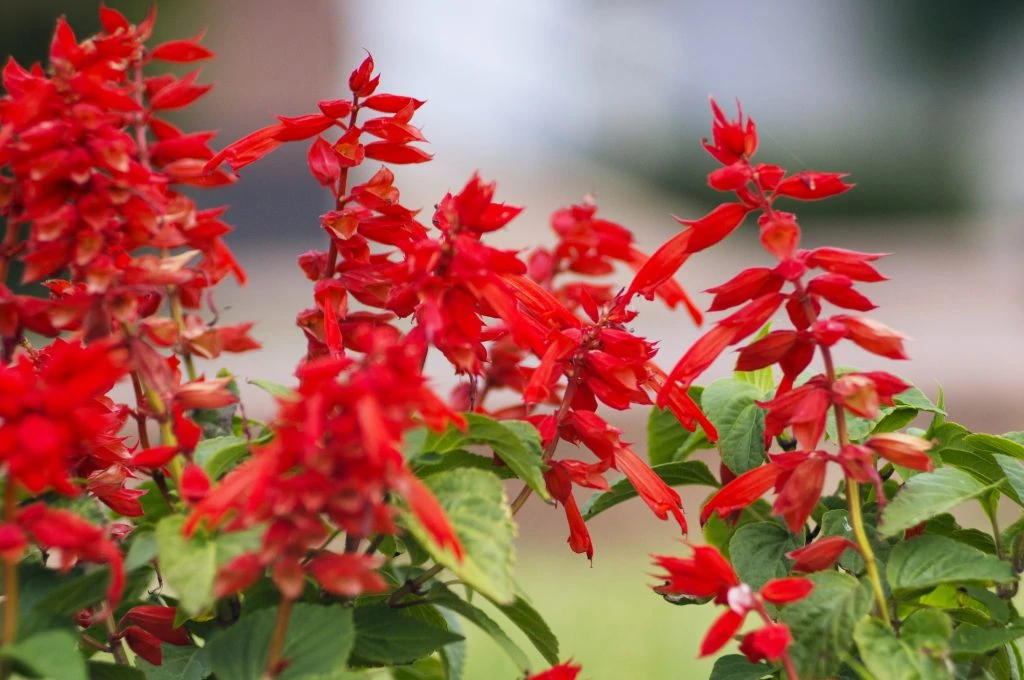
With over 1000 species of these members of the mint family, salvias are a great perennial to choose for hummingbirds. They are also drought-resistant and easy to care for.
Salvias evolved alongside hummingbirds in the Americas, and they use the hummingbirds’ long bills to enter the flower and open a trapdoor that deposits pollen on their heads and rewards them with rich nectar.
They put on a rich display of flowers and tubular blossoms all summer that keep the hummingbirds coming back.
Many native species of salvia are drought tolerant and grow happily in the heat of the South. Although salvias are heat and drought tolerant, if it is very dry, then water thoroughly once a week.
Sometimes known as sage plants, they can be grown as annuals, but also perennial varieties are available. Deadhead them during the summer to encourage more flowers but leave flowers on at the end of the season, so they reseed.
Choose Salvias with red, pink, and orange-colored flowers. Native species are best, but Salvias from Europe are hardier and will grow further north, extending the range and nectar availability for hummingbirds.
- Common Name: salvia
- Scientific Name: salvia
- Growing Zones: 4 – 10
- Sun: Full sun, but some will tolerate partial shade
- Soil: Well-drained
- Colors: Red, pink, purple, blue, white, yellow.
- Height: 1 – 6 feet
- Spread: 1 – 6 feet
- Plant Type: Annual, Perennial
19. Flowering Currant
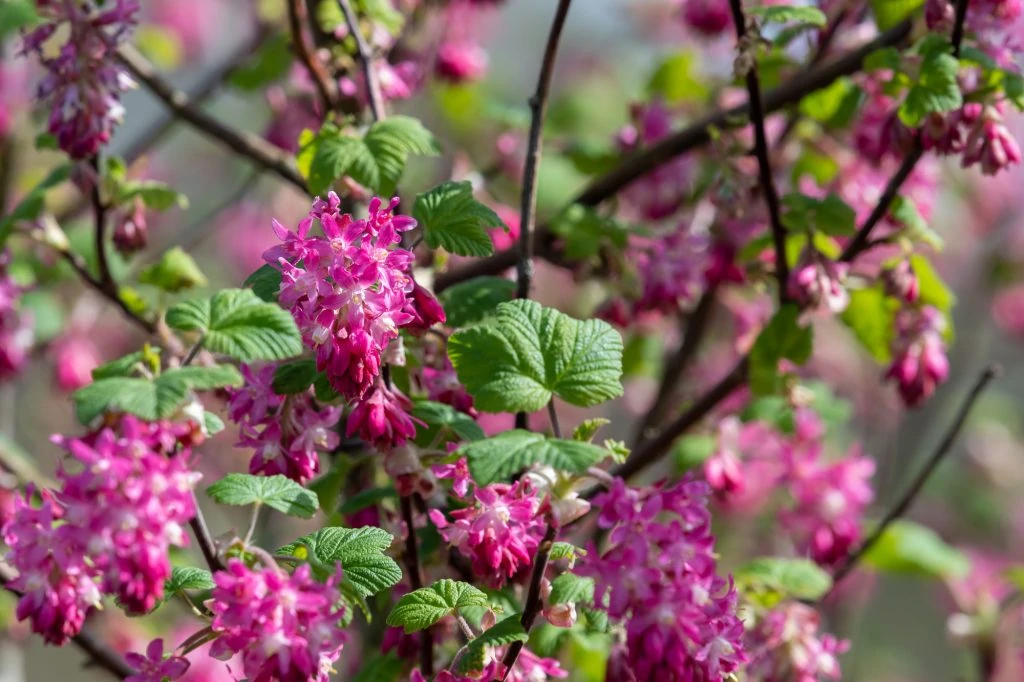
The Flowering Currant, Latin name Ribes sanguineum, is a large deciduous shrub growing up to 10 meters tall, native to the western United States and Canada. They are considered an ornamental plant because of their lovely reddish flowers, but they’re also cultivated for food because of their edible berries for humans and animals.
The Flowering currant, also called red-flowering currant or redflower currant, is multi-stemmed with upright arching stems. With careful pruning, it can be cultivated as a tree with rounded branches. It thrives under the full sun but can be grown in partial shade. It is drought-tolerant, but ideally, you should keep the soil moist.
The flowers of the Flowering Currant are wildly attractive to hummingbirds and bees during early spring (April to May). They’re clusters of 10-30 flowers, each cluster as long as three inches. The flowers are light pink to red that seemingly cover the stems and sometimes hang from them.
The leaves are deep green that are shaped like small maple leaves. They appear at the same time as flowers, and when they’re young, they emit a type of woodsy scent. They’re essential because moths and butterfly larvae eat them.
During the fall, blue-black fruits appear. Songbirds love these berries. People may use the berries for jams and syrup.
- Common Name: Flowering Currant
- Scientific Name: Ribes sanguineum
- Growing Zones: 5 – 9
- Sun: Full sun or partial shade
- Soil: well-drained soil
- Colors: light pink, red
- Height: 10 feet tall
- Spread: 5 feet
- Plant Type: Perennial, Deciduous shrub
20. Penstemon
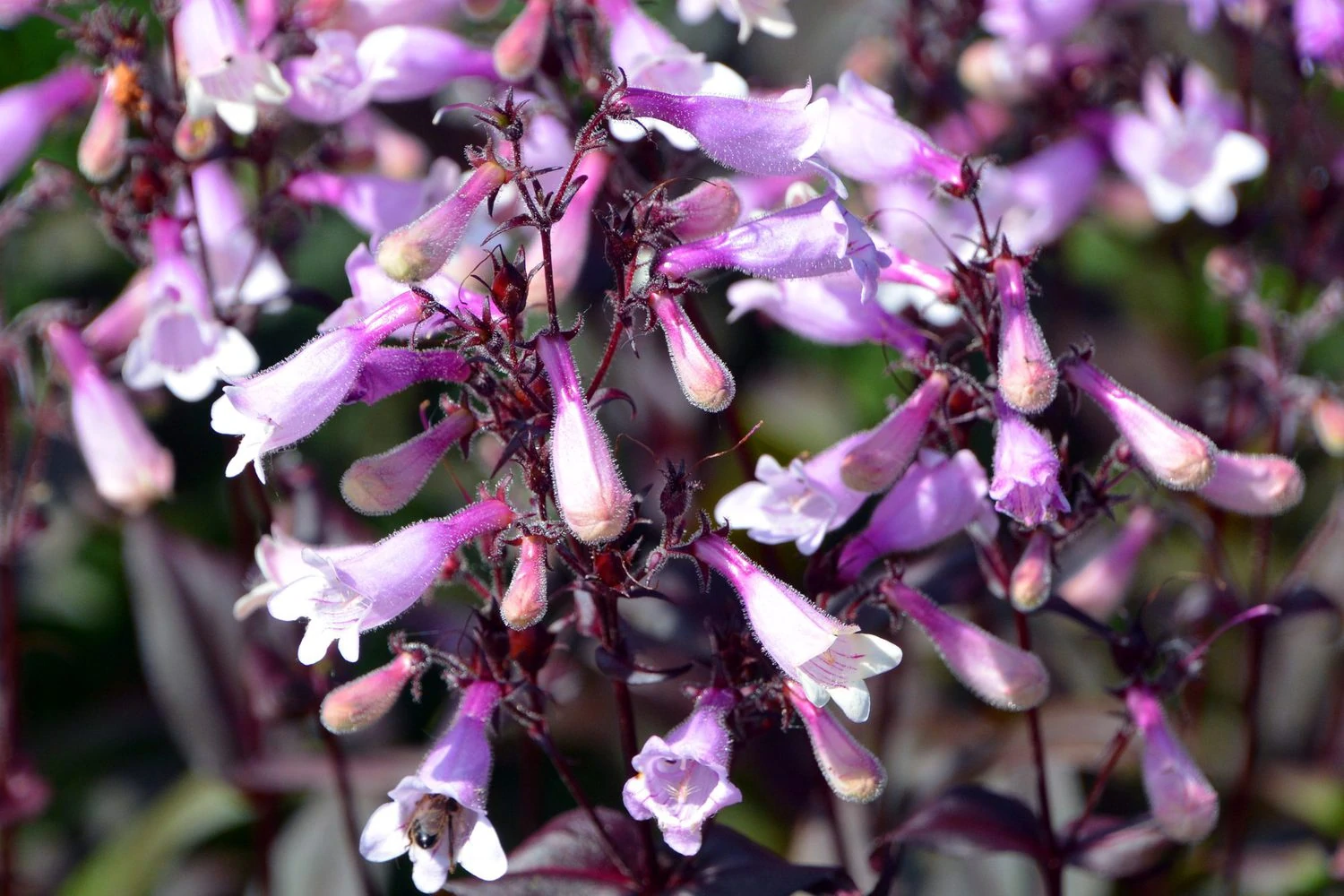
Penstemon is a genus belonging to the plantain family (Plantaginaceae), with over 250 different ornamental flowering plants, like snapdragons and foxgloves. It is also called Beardtongue because the pollen-free stamen that protrudes from the flowers has a tuft of small hairs.
With a wide number of species, there are many varieties of Penstemon to choose from to suit your backyard. They may have different sizes and different colors, but they all share these things- they’re all drought-tolerant, they attract hummingbirds and bees, they’re easy to take care of, and their lovely blooms brighten up any backyard.
Flowers of the Penstemon genus bloom in early summer. They become a focal point in a garden setting because of their spires and a colorful cluster of tubular flowers. There are many colors to display depending on the variety you’ve chosen. There are blue, purple, red, orange, white, pink, and yellow.
Hummingbirds always flock to Penstemon because they’re bright and colorful, and they’re nectar-rich.
The best place to plant penstemons is where they can get full sunlight. Flowers will bloom profusely, and stems will remain upright instead of drooping because of shade. They prefer nutrient-poor soil with moist conditions. They can tolerate drought, but it’s also good to give them a good watering every once in a while. It’s better to choose a variety suited to your soil condition and climate to make them last longer.
- Common Name: penstemon, foxglove beard-tongue, foxglove beardtongue, talus slope penstemon, and white beardtongue
- Scientific Name: penstemon
- Growing Zones: 3 – 9
- Sun: Full sun
- Soil: lean, fast-draining soil
- Colors: Blue, Purple, Red, Orange, White, Pink, Yellow
- Height: 6 to 12 inches, 1 to 3 feet, 3 to 8 feet
- Spread: 8 to 20 inches
- Plant Type: Perennial
21. Cape Fuchsia
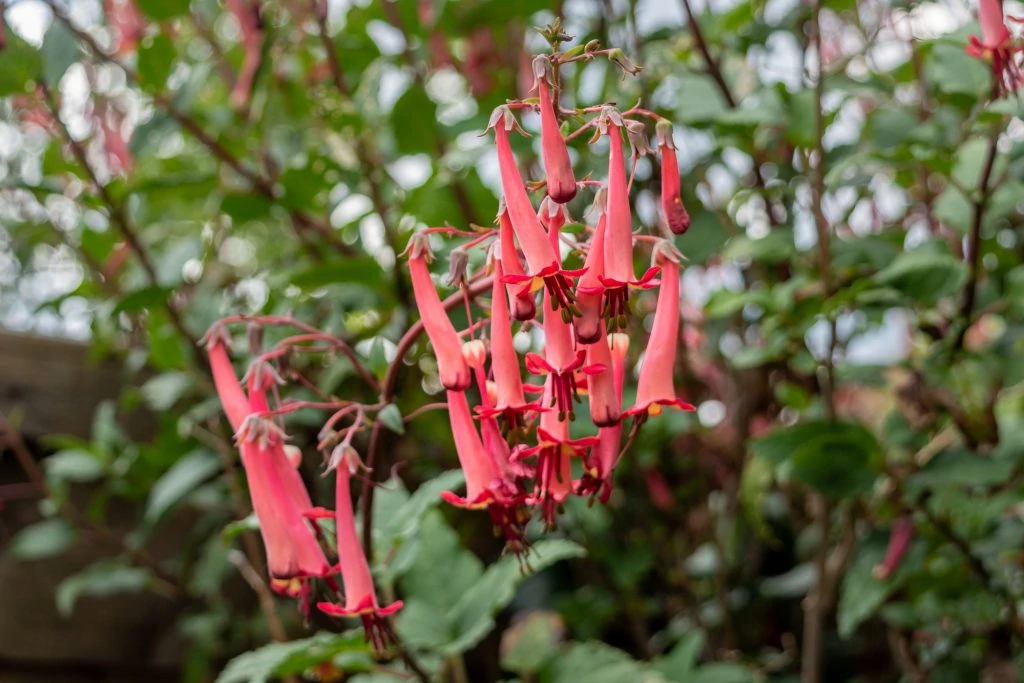
Cape Fuchsia, Latin name Phygelius capensis, is a flowering plant from the family Scrophulariaceae. It is a semi-evergreen shrub that can grow from 3 to 5 feet and is native to South Africa, and its name comes from the Cape of Good Hope.
What makes Cape Fuchsia a good ornamental plant is its long flowering season. From May to November, you can enjoy its brilliant colors, depending on the variety that you have. There are yellow, peach, coral, magenta, and red variants that are 2 inches long, tubular, and hang upright or vertical on stems.
Cape Fuchsia is easy to take care of because it is not picky about the soil you place it in as long as it receives just the right amount of water and a full dose of sunlight. It grows and spreads fast too from its underground stems, so you just need to make sure to constrict it to its space so it won’t overwhelm other shorter plants.
It’s pretty drought-tolerant, but you have to keep the soil moist when the weather becomes too hot. Also, when it’s too hot, it wouldn’t hurt to bring it under partial shade. It flowers for a long time too, which is a really good treat for hummingbirds.
- Common Name: Cape Fuchsia
- Scientific Name: Phygelius capensis
- Growing Zones: 5 – 7
- Sun: Full sun
- Soil: well-drained soil
- Colors: yellow, peach, coral, magenta, red
- Height: 3 – 5 feet
- Spread: 3 – 5 feet
- Plant Type: Perennial, annual
22. Weigela
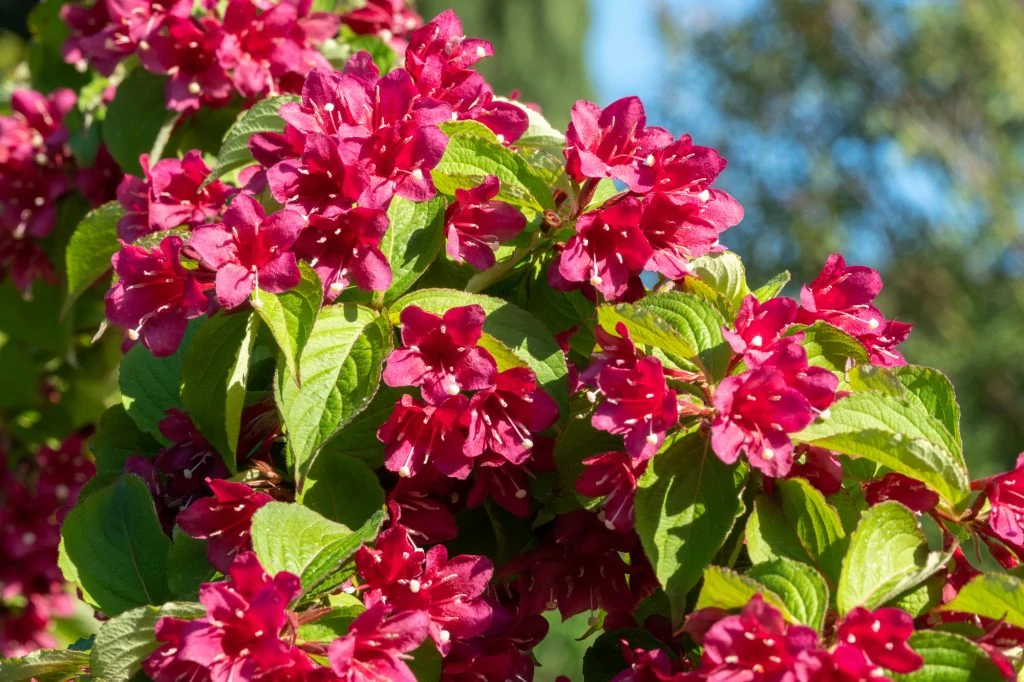
Weigela are a favorite flower of hummingbirds and butterflies because of their pink and reddish colors, although there are varieties of Weigela that are yellow and lavender. The flowers are tubular-shaped, about 2 cm long, and form clusters. They flower from early spring to late summer.
Weigela are a group of 6 to 38 species of flowering deciduous shrubs from the family Caprifoliaceae. All of the flowers are natives of East Asia, the most popular variety is the Weigela florida. The “florida” does not represent the state of Florida but instead stands for “florid” or “covered with flowers”.
The leaves of Weigela are also as interesting as the flowers. They come in different shapes – some are long, some are oblong, and some have a serrated edge. Normal colors are green, but there are others that are variegated (dual-colored), gold, and burgundy.
These Weigela plants are perfect ornamental plants, whether you use them as specimen plants when they bloom or as hedge plants because of their dense foliage. The key is to put them in moderately acidic soil that is well-draining. They flower best when receiving full sunlight, but they can still grow in partial shade.
Weigelas are easy plants to take care of and have the advantage of being drought-tolerant too. They hardly need water unless the weather has been exceptionally hot, so they may need just enough to keep their soil moist.
- Common Name: Weigela
- Scientific Name: Weigela
- Growing Zones: 4 – 8
- Sun: Full sun, partial shade
- Soil: Well-drained, moderately acidic soil
- Colors: red, pink, white, yellow, and lavender
- Height: 3 – 10 feet tall
- Spread: up to 12 feet
- Plant Type: Perennial, Deciduous
23. Columbine
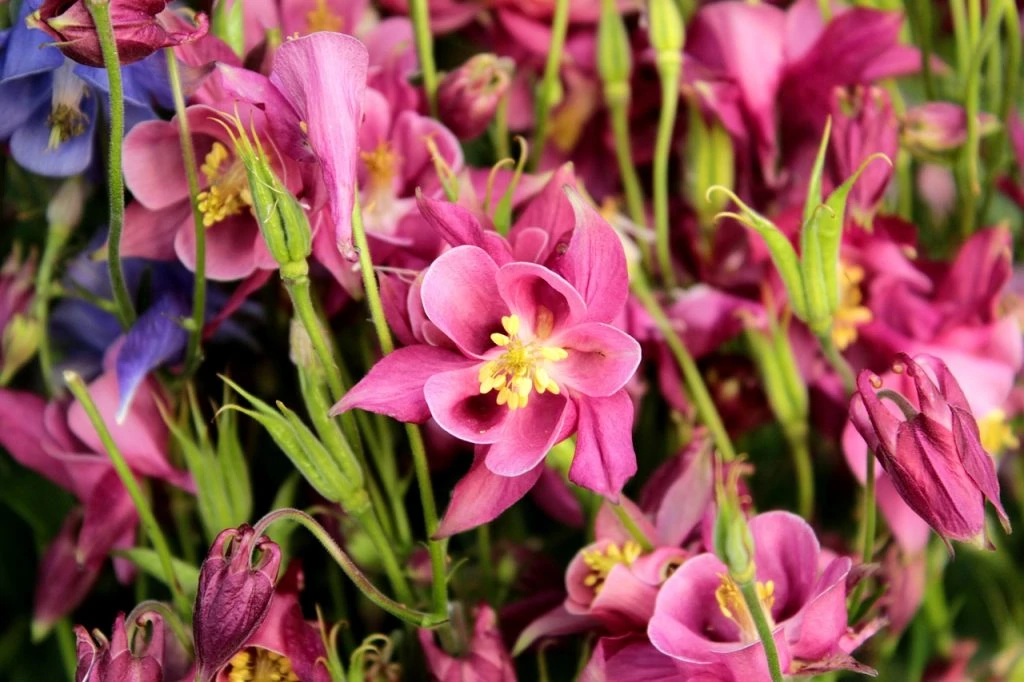
Columbines are one of the best plants to attract hummingbirds because their flowers come in a range of vibrant colors, and they grow well in partial shade.
Columbine is an elegant perennial plant with spiky, bell-shaped blooms that measure anywhere from 3 to 6 inches long. They are also known as Aquilegia.
There are many different varieties of columbine, but most grow in the sun to full shade and flower as early as spring, so they are a great option to start with if you’re trying to attract hummingbirds.
This hard-working flower is not only shade-tolerant, but they are also drought tolerant and deer resistant.
Sow the Columbine seeds directly in the ground in spring, and then they will self-seed if left at the end of the flowering season. If you want to get ahead, then sow the seeds indoors 6 to 8 weeks before the last frosts. Flowers will not appear on seed-grown plants until their second year.
- Common Name: Columbine, Aquilegia
- Scientific Name: Aquilegia
- Growing Zones: 3-9
- Sun: Full sun to partial shade
- Soil: Neutral PH, moist but not wet soil
- Colors: Red, Pink, Blue, Orange, White, and Yellow
- Height: 1 – 3 feet
- Spread: 1 foot
- Plant Type: Perennial
24. Bleeding Heart
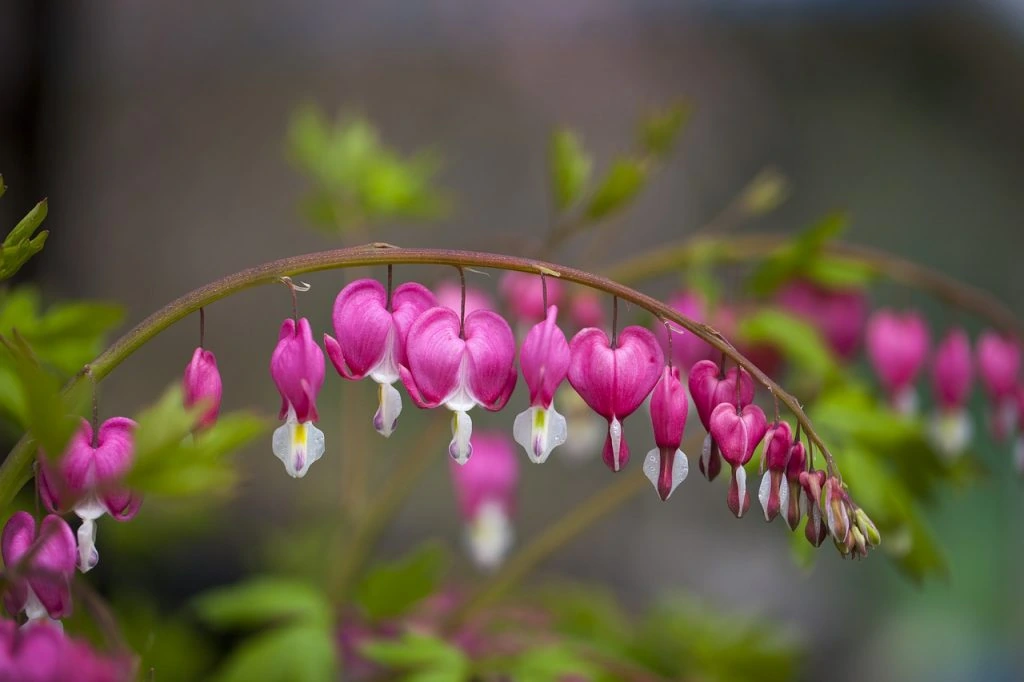
Bleeding Heart flower during the spring and have a lovely sweet smell. They are perennial and require little maintenance, and can be planted in full sun or partial shade.
They make a fantastic addition to a shady corner, and the delicate flowers look amazing arching out of a hanging basket.
If they get too hot or too much sun, they will die back, but the roots will be fine, and the plant will come back the following year. Keep them well watered in the growing season, with the soil moist but not too wet.
It goes dormant in the fall and can be cut back once it starts to yellow, but it will grow back.
- Common Name: Bleeding heart
- Scientific Name: Dicentra spectabilis
- Growing Zones: 3 – 9
- Sun: Partial shade
- Soil: Well-drained, moist
- Colors: Red, White, Pink
- Height: 3 feet
- Spread: 3 feet
- Plant Type: Perennial
25. Crab Apples
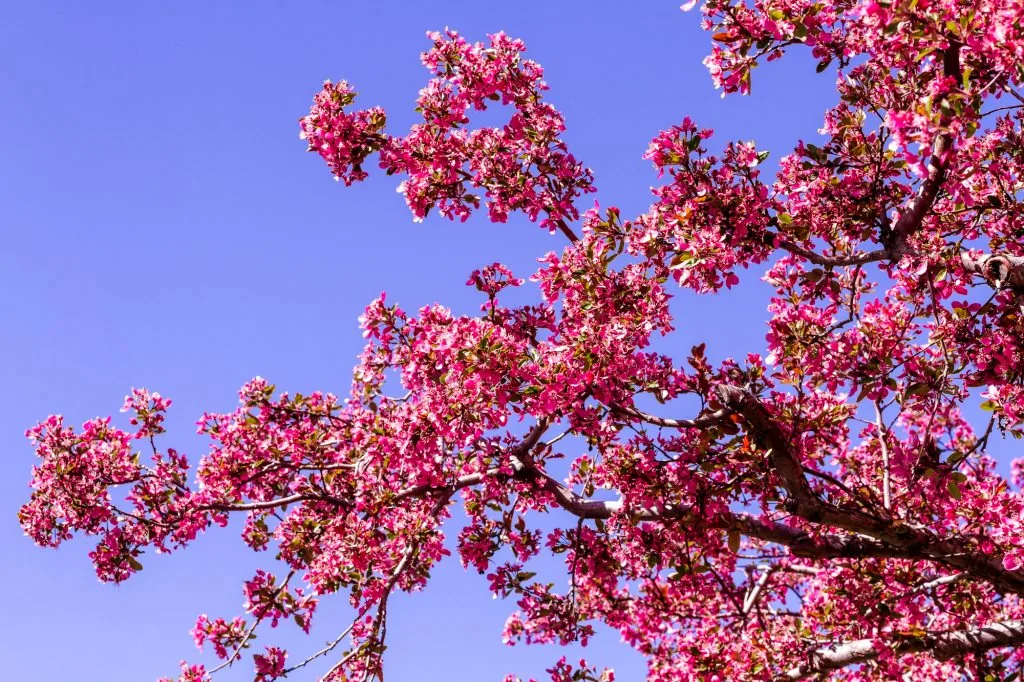
Crab Apples are small deciduous trees that belong to the genus Malus and the rose family, Rosaceae. Their origins may be traced to Russia and Asia, but they now inhabit temperate regions of North America. They are popular ornamental, fruit-bearing trees with colorful blossoms and great leafy foliage.
Crabapples put on quite a display during spring when their flowers bloom. You’ll see a profusion of white, pink, magenta, red flowers opening from darker-colored buds generally for a 4-5 week period.
There are many varieties of crabapple trees, so their flowers also come in many different forms. There are single (five petals), semi-double (6-10 petals), and double (more than ten petals) blossoms. Hummingbirds keep coming back to these large, colorful, and bountiful flowers.
Aside from crabapple blossoms, their foliage is also a sight to behold in the fall. Ordinarily, they have green and dark green leaves, while some varieties have reddish and purplish leaves. But come fall, their leaves turn gold-yellow, red, orange, or bronze before they fall on the ground.
Crabapple fruits are also a reason why these trees attract birds and other mammals. From fall into winter, the trees are filled with orange, bright red, yellow, and many shades or variations of fruits. They come in many sizes, too depending on the trees.
Whether you go for a large crabapple tree or a small crabapple tree, you can look forward to many blooms and fruits that also bring hummingbirds to your backyard.
- Common Name: Crab apple, Crabapple
- Scientific Name: Malus sylvestris
- Growing Zones: 4 – 8
- Sun: Full sun
- Soil: rich, loamy, well-drained soil
- Colors: white, pink, or red
- Height: Small-10-15 ft, Med – 15-20 feet, Large – up to 40 feet
- Spread: up to 12 meters wide
- Plant Type: Perennial
26. English Hawthorn
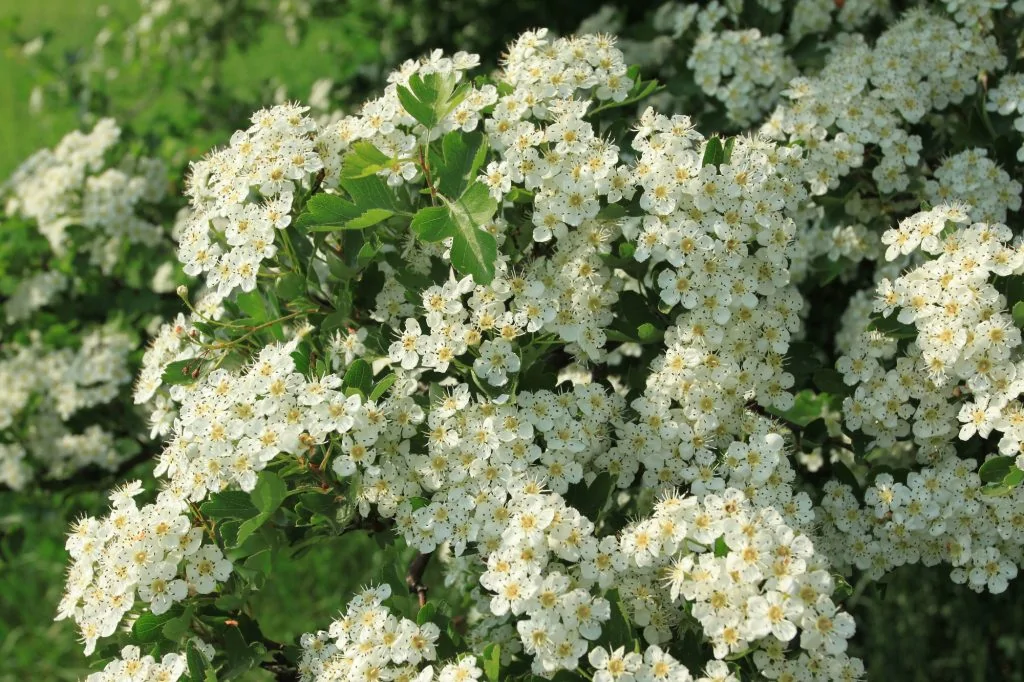
The English Hawthorn (Craetaegus Laevigata), also commonly called Midland hawthorn or Woodland hawthorn is a deciduous, thorny tree that originated in Europe and North Africa. It is similar to apple, pear, and crabapple trees that bloom profusely during spring.
English Hawthorn trees are small to medium-sized trees that can reach up to 30 feet high. They are tolerant of drought and poor soil conditions and can be confined to small spaces, which is why they are popular as street trees, in landscapes, and as bonsai trees.
In springtime, these English Hawthorn trees will flower radiant colors of white, pink, lavender, and red. They grow in flat clusters of 6 to 12 flowers, each with five petals, along its branches. When these flowers fade, small red or orange fruit will start to grow from summer into winter. These red and orange fruits provide a great contrast against the white tree in winter.
When planting your English Hawthorn, make sure to plant them where fallen fruit is not an issue. They also grow slowly but will live for as long as 150 years.
- Common Name: English Hawthorn, Midland hawthorn, or Woodland hawthorn
- Scientific Name: Craetaegus Laevigata
- Growing Zones: 3 – 9
- Sun: Full sun
- Soil: moist, well-drained
- Colors: white, pink, lavender, red
- Height: 6 to 30 feet tall
- Spread: 6 to 30 feet wide
- Plant Type: Perennial, Deciduous tree
27. Eucalyptus
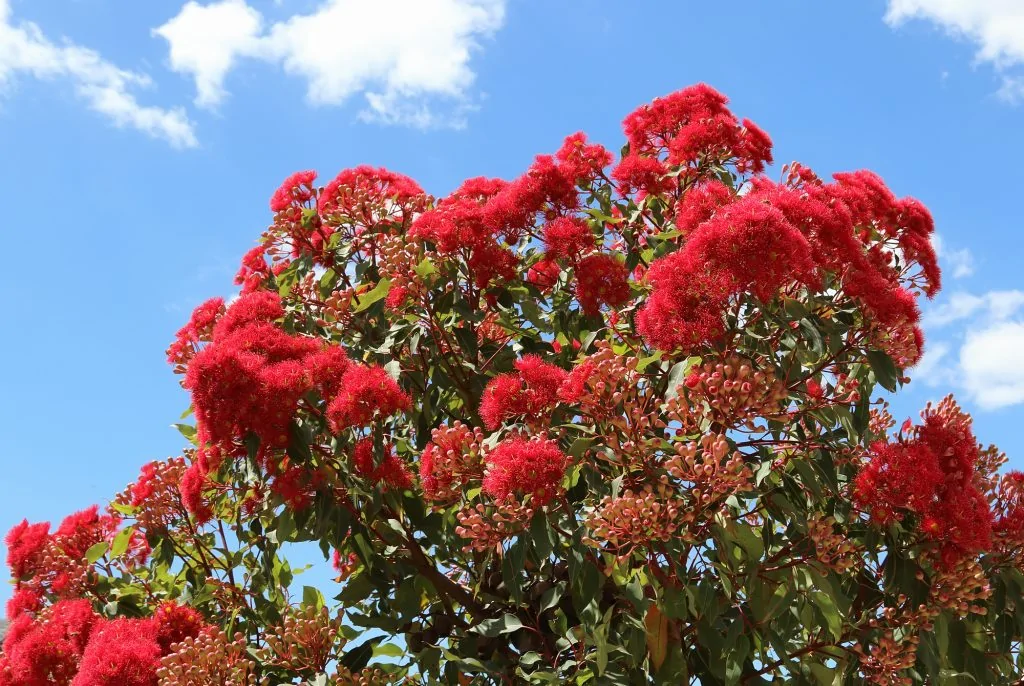
Eucalyptus are a large group of 700 species of flowering trees and shrubs. Almost all species are native to Australia, but some have found their way into Hawaii, California, Arizona, western Washington, western Oregon, and southwestern British Columbia.
Eucalyptus trees are also called gum trees or stringybark trees and are considered invasive species in places like California because they are highly flammable, so do not plant them in fire risk states.
Though most eucalyptus trees grow as tall as 800 feet in the wild, there are eucalyptus varieties that you can grow in your backyard like the Red-Flowering gum (Eucalytpus ficifolia) and the Silver dollar eucalyptus (Eucalyptus cinerea) that can reach from 20 to 50 feet tall. They provide good shade because of their height.
They’re also easy to maintain in urban areas because they can grow in any type of soil as long as it’s well-drained. However, they’re most suited for regions with tropical temperatures, like in zones 8-11. They don’t do well in the cold.
What’s fascinating about eucalyptus trees is that they technically have no flowers because they have no petals. The flowers that you would see are actually the numerous stamens that are freed from their petal-like enclosure. They are usually colored white, yellow, orange, pink, or red.
Hummingbirds, bees, and butterflies love the eucalyptus trees because they produce a large amount of nectar. Bees can use it to make eucalyptus honey. Hummingbirds also love the scarlet color of the blossoms, and they even make their nests in Eucalyptus trees.
- Common Name: Eucalyptus, Gum Tree
- Scientific Name: Eucalyptus
- Growing Zones: 7 -11
- Sun: Full Sun
- Soil: well-drained, slightly acid soil
- Colors: white, yellow, orange, pink, red
- Height: up to 120 feet tall (note: Pacific Northwest varieties) 820 feet (250 m) (Wild)
- Spread: 25 to 57 feet wide (note: Pacific Northwest varieties) 500 feet (150 m) (Wild)
- Plant Type: Perennial, Evergreen Tree
28. Red Buckeye
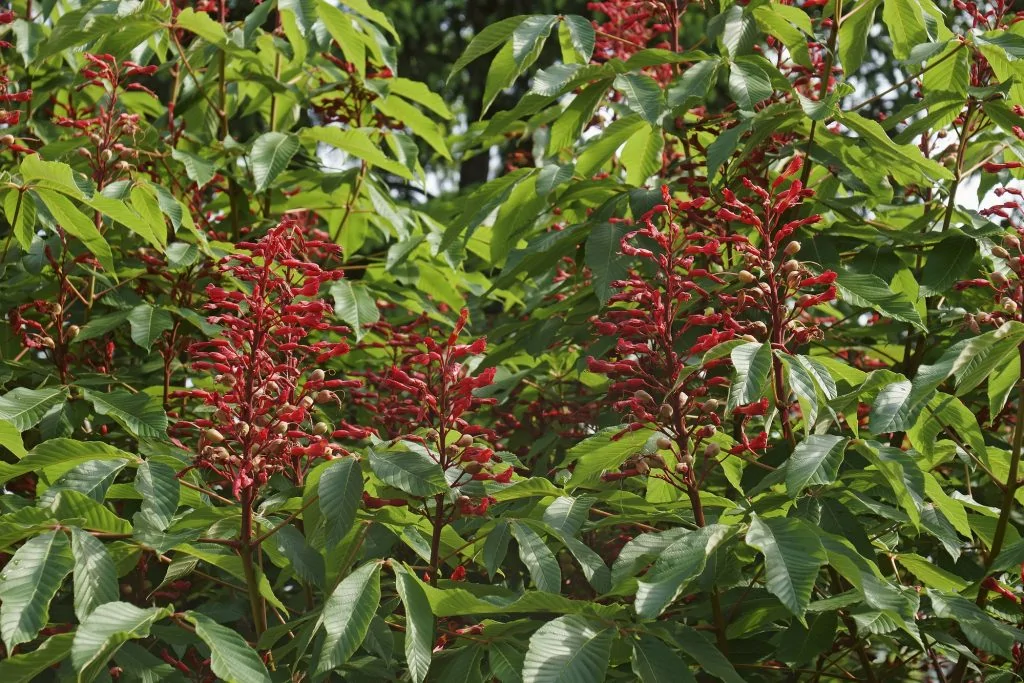
Red Buckeye (Aesculus pavia) is a large shrub or a small tree that’s native to the Southeastern United States. Its other names include Scarlet Buckeye and Firecracker plant. They can be single-trunked trees or shrubs or multi-trunked trees, depending on how you prune them.
The attraction of the Red Buckeye are numerous red, tubular flowers that bloom in the spring. These red flowers belong to the typical Red Buckeye, but there are also yellow flowers that are the flavescens variety of the Aesculus pavia.
These red flowers are extremely attractive to hummingbirds and bees because they rise upright from the leaves.
The leaves of the Red Buckeye are a good contrast to the bright red flowers. They are composed of 5 leaflets connected to a central point. They’re shiny and glossy, dark green above and whitish on the underside.
Red Buckeyes are easy to grow and maintain because they can be grown in any soil texture, but they thrive when in moist and well-drained soil. You can grow them in the shade, but you may stunt their growth, and they will remain as small shrubs.
While the Red Buckeye looks brilliant when it is in full bloom, caution must be exercised as almost all their parts, bark, flowers, fruits, leaves, seeds, and stems, are poisonous and toxic to humans.
- Common Name: Red Buckeye
- Scientific Name: Aesculus pavia
- Growing Zones: 4 – 8
- Sun: Full sun or partial shade
- Soil: all soil textures
- Colors: red or yellow
- Height: 15 – 20 feet tall
- Spread: 15 – 25 feet wide
- Plant Type: Perennial, Deciduous flowering tree
29. Eastern Redbud
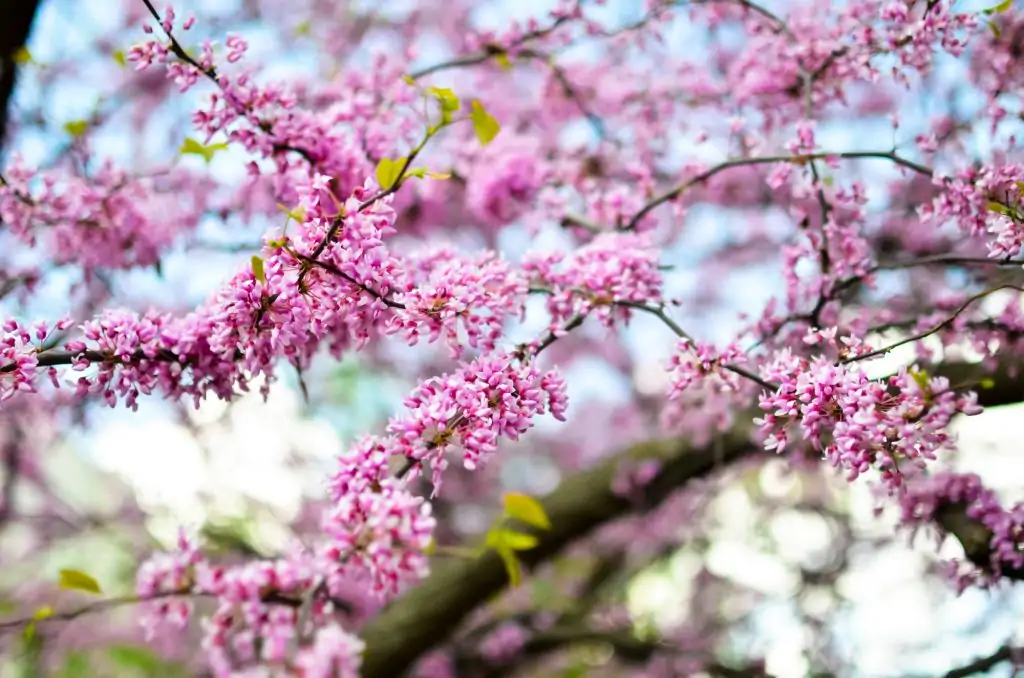
The Eastern Redbud, Cercis Canadensis, is a large deciduous shrub or small tree native to eastern North America. It is grown as an ornamental specimen plant for its twisted trunk, zigzag branches, beautiful flowers, and large, heart-shaped leaves. It is also just the right size for a small to medium backyard.
What makes the Eastern Redbud interesting is that its flowers appear before the leaves when they bloom in early spring. So, they’re really the focal point of the tree once they start flowering. The half-inch wide flowers grow in clusters on the branches, each with 4-8 flowers. Only hummingbirds and long-tongued bees, like blueberry bees and carpenter bees, can reach the nectaries.
Eastern Redbud flower colors range from light pink to deep magenta, and some even have a purplish tinge. With their bright colors against the dark branches and trunk, the flowers appear to be just floating in the air in the right kind of light. You can enjoy this display for 2 to 3 weeks before the fruits appear.
Once the flowers disappear in mid-summer, their fruits or legumes appear. They look like bean pods that start out green when they first come out but will, later on, turn brown as winter approaches.
Leaves then appear as winter buds, initially bright green with a tinge of red, and when they unfurl and expand, they are heart-shaped. They are bright green, glossy, and have prominent veins.
Eastern redbuds can be grown in full sun and partial shade, but if you want them to bloom profusely, it’s better to give them 6 hours of sunlight. While they may tolerate drought, it’s still better to keep them watered regularly. You may also prune them while young to give them shape and structure.
- Common Name: Eastern Redbud
- Scientific Name: Cercis Canadensis
- Growing Zones: 4 – 9
- Sun: Full sun, partial shade
- Soil: moist, well-drained soil
- Colors: pink, reddish, purple
- Height: 20 to 30 feet tall
- Spread: 25 to 35 feet wide
- Plant Type: Perennial, Deciduous tree
30. Flowering Tobacco
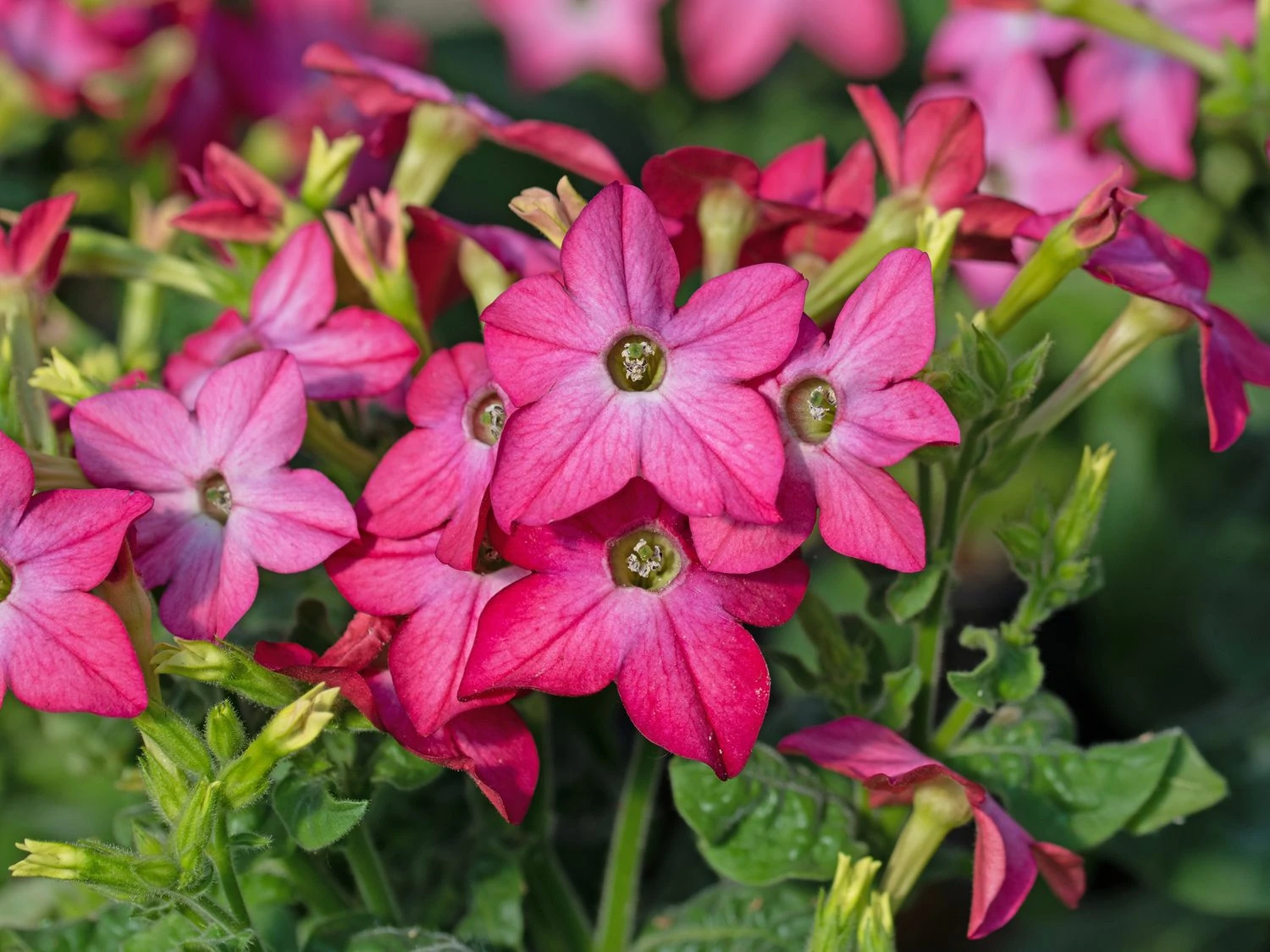
Flowering tobacco plants belong to the family Nicotiana, a group of herbaceous tobacco plants. They are relatives of the true tobacco plants, are usually grown as ornamental plants, and come in different varieties.
If you want fragrant flowering tobacco plants in your garden, you may opt for Nicotania sylvestris or Nicotiana alata, two of the more common and popular varieties. They emit a jasmine fragrance every evening.
Nicotiana sylvestris have wide, oblong leaves and in the center of it rises a central flower spike that can grow several feet tall. There are many tubular, pendant, white, or cream flowers that bloom from June until the first frost. Nicotiana alata plants are also tubular, but they bloom from tall, graceful stems. Their flowers are white and star-shaped and emit sweet perfume at night.
These types of flowering tobacco are easy to plant and grow, requiring full sun or part shade and well-draining soil. What’s more, they’re a great attraction for hummingbirds with their tube-like flowers and fragrance.
However, they may be short-lived since they’re considered annual plants. But, they’re self-seeding, so you can continue to enjoy them for the following year. Just make sure to protect them from the cold and extreme heat.
- Common Name: Flowering tobacco, Jasmine tobacco
- Scientific Name: Nicotiana family
- Growing Zones: 10 – 11
- Sun: Full sun to part shade
- Soil: organically-rich, moist, well-draining
- Colors: white, yellow, pink, red, yellow-green, purple
- Height: 6 to 12 inches, 1 to 3 feet, 3 to 8 feet, 8 to 20 feet tall
- Spread:6 inches to 10 feet, depending on the variety
- Plant Type: Annual
31. Zinnia
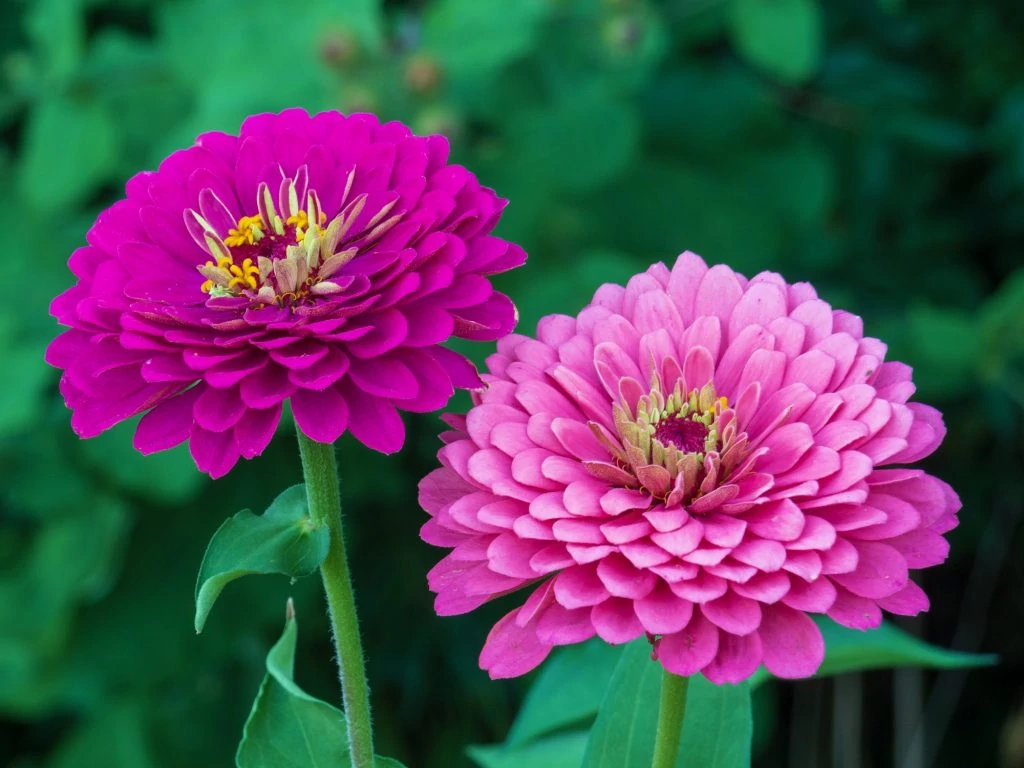
Zinnias are flowering shrubs native to the scrub and dry grasslands of North America. They belong to the genus Heliantheae or the sunflower tribe and to the much larger daisy family, Asteraceae.
There are three main types of zinnias based on the kind of petals that they have. Single-flowered zinnias have a single row of petals with a visible center. Double-flowered zinnias have numerous rows of petals with no visible center. Semi-double-flowered zinnias have numerous rows and visible centers.
The Zinnia elegans, with its tall stems and bright colors, is considered a classic and is most popular for backyards and gardens. It reaches 4 feet tall, has many brilliantly-colored flowers, has a long blooming period from early summer to frost, and attracts pollinators like butterflies and hummingbirds.
Growing zinnias is easy, but you have to plant them directly where you want them because they don’t like being transplanted. But once they become established under full sun and well-draining soil, you will be able to enjoy their bright blooms for a long time.
- Common Name: Zinnea, Zinnia
- Scientific Name: Zinnia elegans
- Growing Zones: Annuals in 2-8, Perennials in 9-11
- Sun: Full sun
- Soil: neutral to slightly alkaline, well-draining
- Colors: white, yellow, orange, pink, red, purple
- Height: 1 – 4 feet tall
- Spread:12 – 18 feet wide
- Plant Type: Annual, Perennial Shrubs
32. Crocosmia
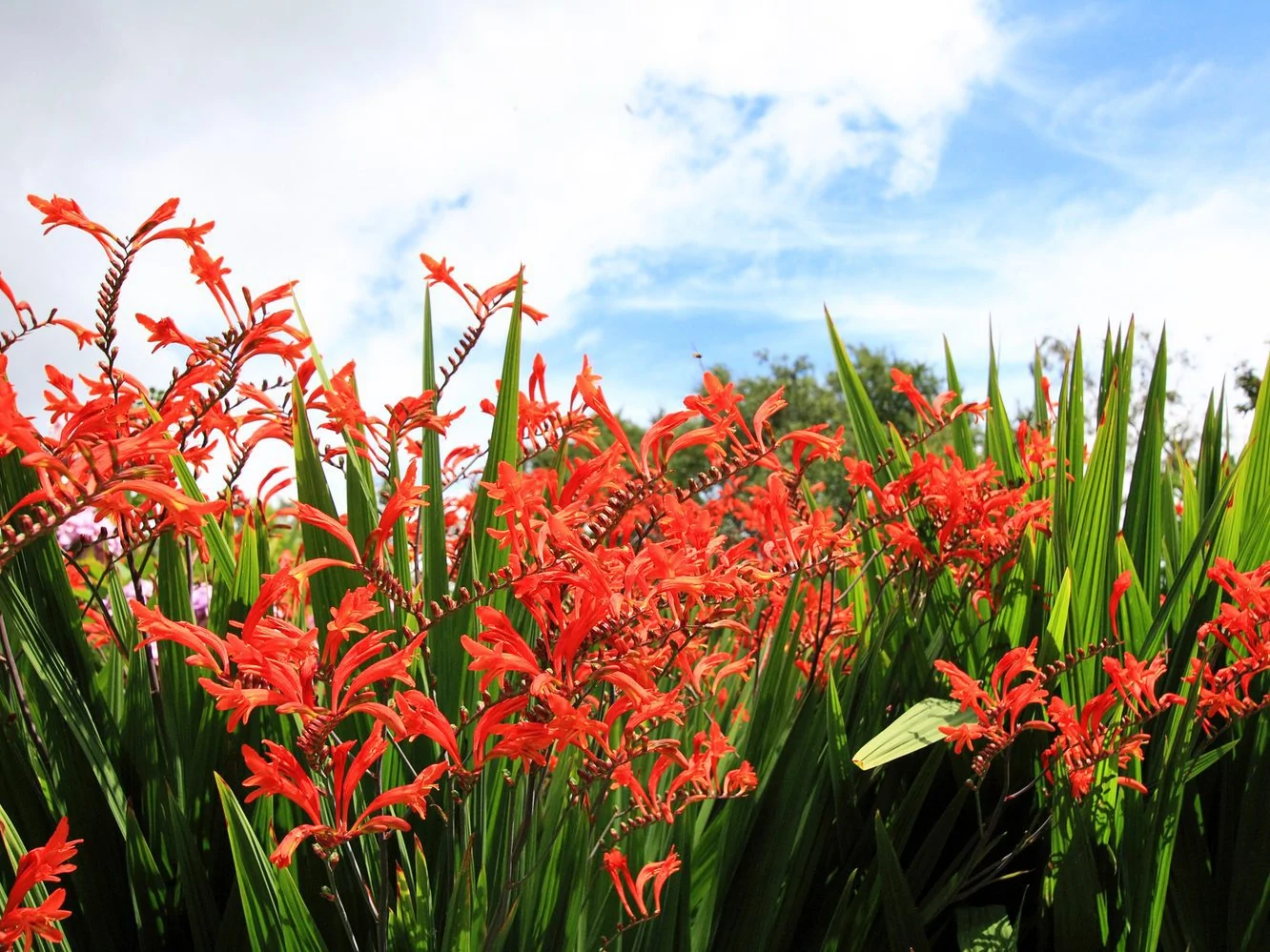
Crocosmia, commonly known as montbretia or coppertips, are flowering plants from the Iris family, Iridaceae. They are native to southern and Eastern Africa but have found their home all over the world.
The flowers of Crocosmia are trumpet-shaped and brightly colored red, orange, and yellow. When planted in moist, well-draining soil and exposed to full sun, these flowers bloom season after season in zones 5 to 9. These are ideal traits for attracting hummingbirds and other pollinators and having them return to your backyard.
When the flowers are not in bloom, the striking foliage of Crocosmia also provides visual interest. They are sword-shaped, bright green, and grass-like which add vertical movement to your backyard.
Crocosmia plants grow from corms or underground stems stocked with food supply to help plants survive winter. You plant them in the spring when frost is no longer a threat to the plants. They develop cormlets, so it’s easy to propagate them simply by breaking them off and re-planting them.
Some of the interesting varieties of Crocosmia include Crocosmia Lucifer (red flowers), Crocosmia Emily McKenzie (downward-facing orange blooms), Crocosmia Prince of Orange (20 orange flowers on each stem).
- Common Name: Montbretia, coppertips, falling stars
- Scientific Name: Crocosmia
- Growing Zones: 5-9
- Sun: Full sun, partial shade
- Soil: moist, well-draining
- Colors: red, orange, yellow
- Height: 1 ½ to 4 feet tall
- Spread: 12 to 18 inches
- Plant Type: Perennial
33. Daylily
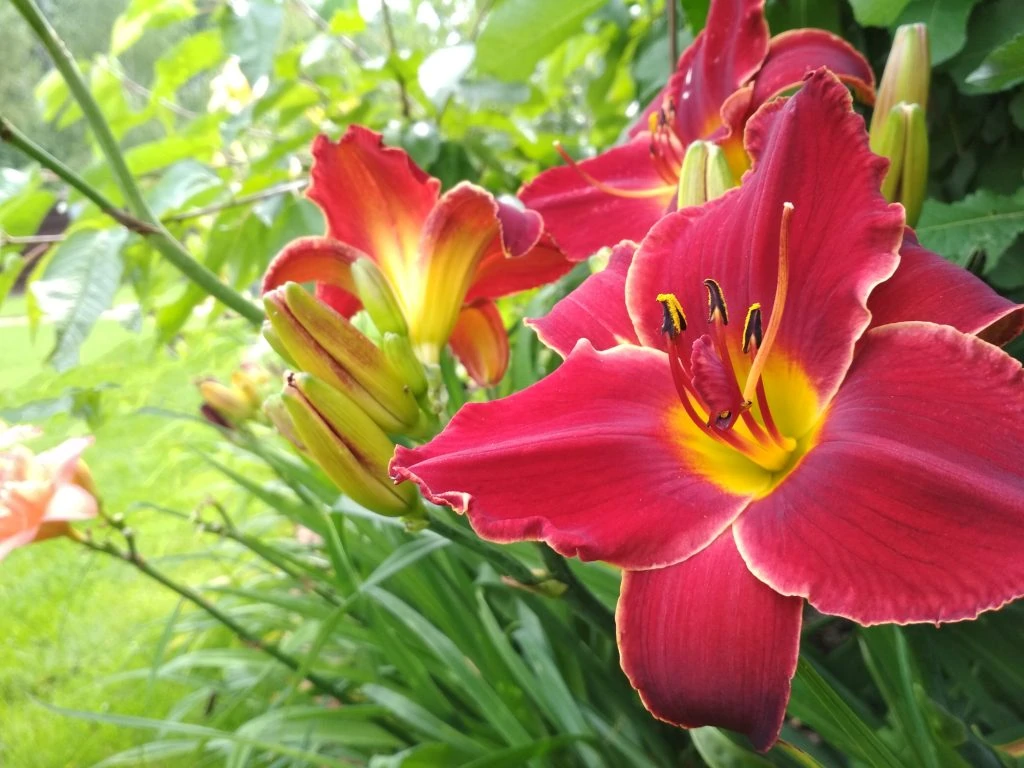
Daylilies are perennial plants from the family Asphodelaceae, popular among gardeners because of their attractive flowers. As many as 35,000 cultivars have been developed in order to create more variants with varying colors, plant hardiness, plant disease resistance, and plant sturdiness.
Daylilies are not true lilies, despite their name. They grow from fleshy roots, not from onion-like bulbs. Their flowers also form on “scapes” or leafless stems that can have as many as 12-15 buds on them. Each mature daylily plant can have 4 to 6 scapes, so you can have plenty of blooms for many seasons.
But, true to their name, daylily flowers only last a day. The good news is that a new flower grows after so that each plant, with its many scapes, can have a lot of blooming flowers from mid-spring to fall.
In order to keep the Daylily plant blooming its brilliantly-colored flowers, they have to be placed in an area that will receive at least six hours of sunlight. While they are drought-tolerant, it’s important to keep them hydrated with water, especially when the scapes and buds are still forming.
Hummingbirds are easily attracted to daylilies because of their bright colors, particularly the reds and purples. They are drawn to the tubular varieties, too because those are the flowers that hold the most nectar.
- Common Name: Daylily
- Scientific Name: genus Hemerocallis
- Growing Zones: 4 – 9
- Sun: Full sun
- Soil: Slightly acidic to neutral
- Colors: white, yellow, orange, pink, red, purple
- Height: 3 to 4 feet tall
- Spread: 2 to 4 feet wide
- Plant Type: Perennial
34. Calibrachoa
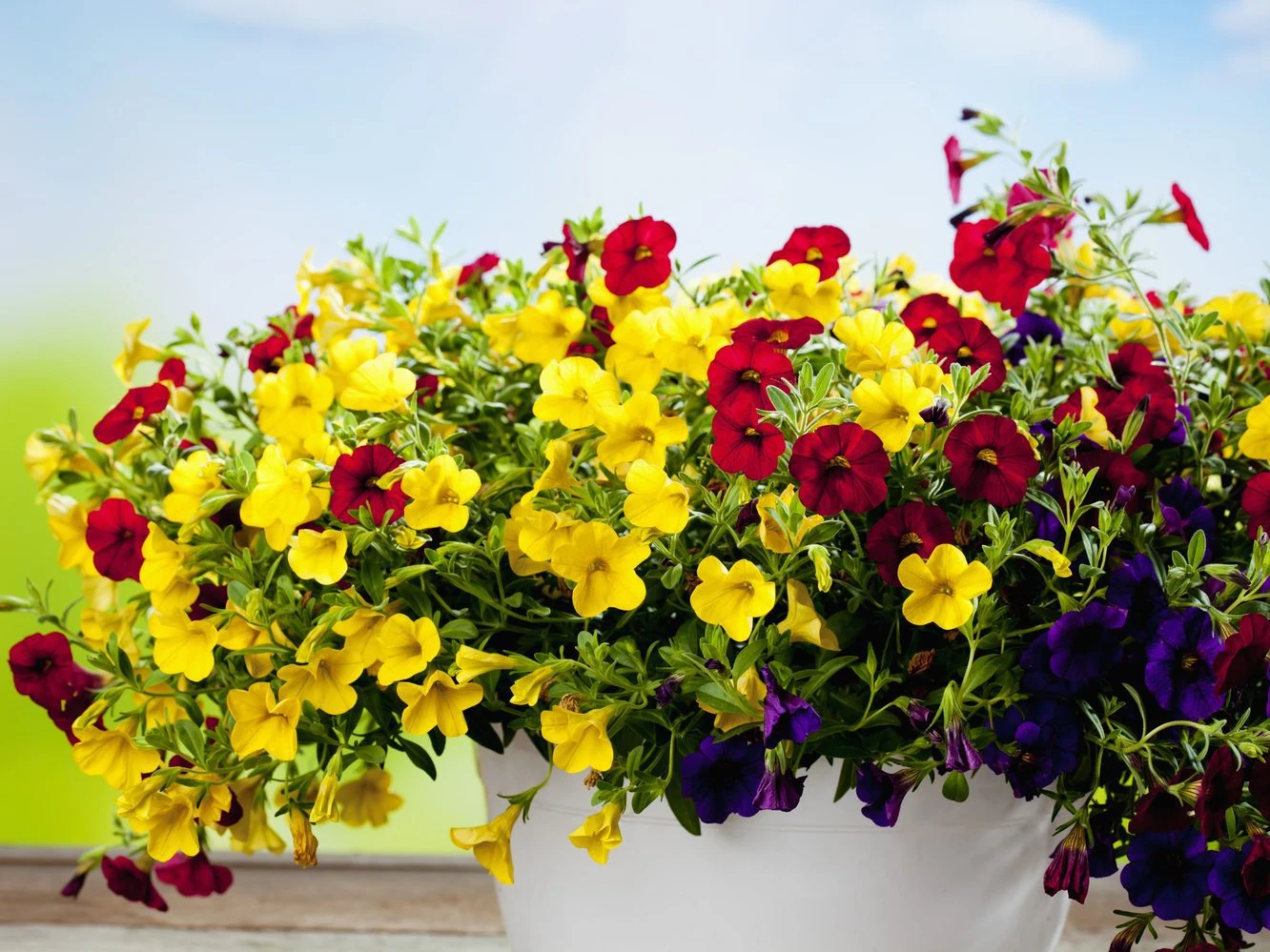
Calibrachoa, more commonly known as million bells or trailing petunia, are small shrubs belonging to the Solanaceae family. They are a relatively new species of ornamental plants, having been introduced only in the 1990s. But they’ve grown popular because of their prolific, colorful blooms that look like small petunias, which is why they’re also called mini petunias.
Calibrachoa plants are well-suited for containers and hanging baskets since they grow so fast and have a tendency to cascade. They can only grow to as high as 12 inches, but they do give you so many flowers you’ll hardly see any foliage.
The flowers of the Calibrachoa plant are small, bell-shaped, and pretty colorful. They come in shades of coral, yellow, orange, red, pink, blue, purple, burgundy, lavender, and cream. There are even varieties that give you dual-colors and veined and segmented petals. Regardless of the diversity of the flowers, calibrachoa flowers attract pollinators like hummingbirds.
They are not hard to grow and maintain. Calibrachoa grows well in full sun and well-draining soil. Just pay attention to the weather because if it gets too hot, you may need to adjust the amount of water that you give them.
- Common Name: Calibrachoa, million bells, trailing petunia, mini petunia
- Scientific Name: Calibrachoa
- Growing Zones: 9 – 11
- Sun: Full Sun to Part Shade
- Soil: Moist, rich, well-drained
- Colors: coral, yellow, orange, red, pink, blue, purple, burgundy, lavender, cream
- Height: 6 – 12 inches tall
- Spread: 12 – 24 inches wide
- Plant Type: Perennial
35. Delphinium
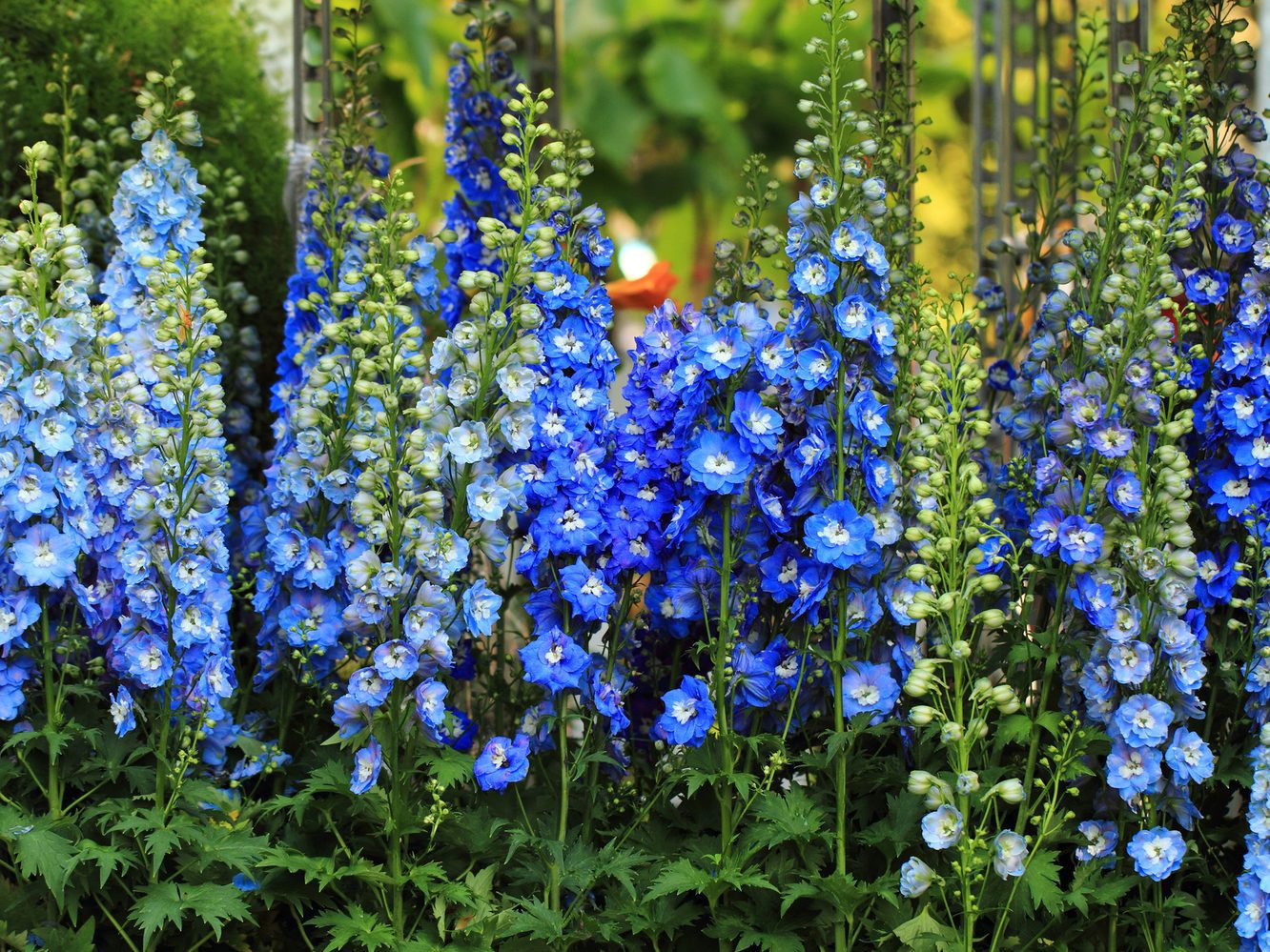
Delphiniums are a genus of about 300 species of flowering plants belonging to the family Ranunculaceae. They are known for their striking, tall, colorful, nectar-rich flowers that are a feast for butterflies, bees, and hummingbirds.
Many gardeners love to plant delphiniums mainly because of their rare blue flowers despite their toxicity and somewhat tricky growing conditions. But, if you’re looking for other colors, delphiniums won’t disappoint because they also have them in pink and red. You can enjoy these flowers from late spring to late summer.
Delphiniums can grow to a height of 8 feet tall in some variants. Their foliage is attractive as well, with their small, palm-shaped leaves. These plants flower well in full sun. It may need to be shielded from too much heat though, and very strong winds. As they grow vertically, you may need to create some support for their stalks, too.
These flowers grow profusely for every stalk and within each flower is a stockpile of nectar that attracts hummingbirds to them. The bright colors of the flowers are already a huge attraction, but having that much available nectar is guaranteed to draw in pollinators repeatedly.
- Common Name: Larkspur, Delphinium
- Scientific Name: Delphinium
- Growing Zones: 3 – 7
- Sun: Full sun, part shade
- Soil: well-draining soil
- Colors: white, pink, red, purple, blue
- Height: 1 to 3, 3 to 8 feet tall
- Spread: 1 to 3 feet wide
- Plant Type: Perennial
36. Lupine
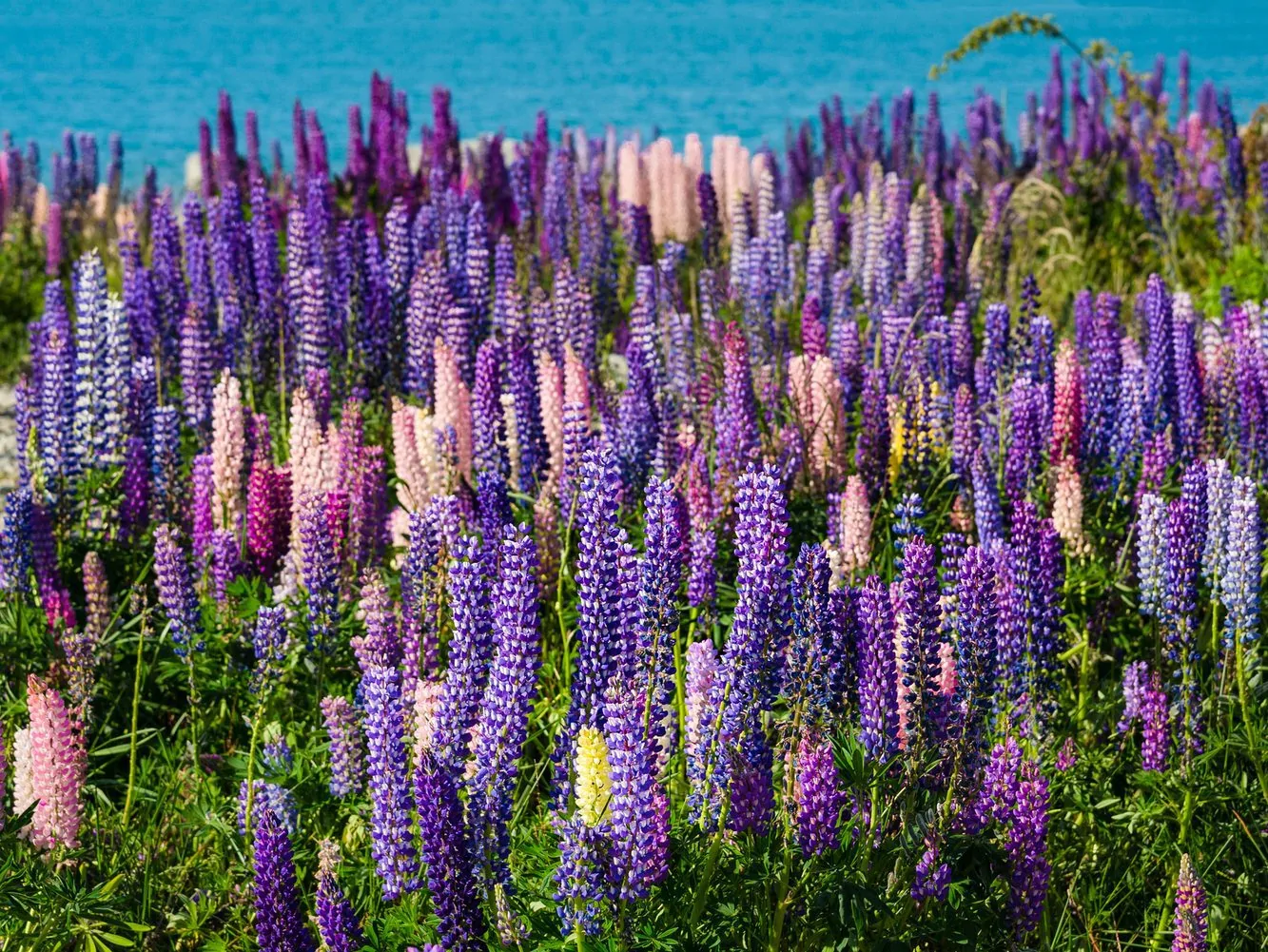
Lupine, or its scientific name Lupinus, comes from the family Fabaceae and is cultivated as an ornamental plant and as a food source, despite having some toxicity that can induce allergic reactions in humans and animals.
It was originally named “lupinus” because it was thought to be “wolfing” the nutrients of the soil. But in truth, it is a nitrogen-fixer plant, meaning it naturally adds nitrogen to the soil. So, if you have any plants that need nitrogen as a fertilizer, Lupines will naturally provide it for you.
With over 199 species of flowering plants, Lupines have such a diverse array of flowers. The Texas bluebonnet (Lupinus texensis) is one popular variant in the United States because of its prolific blue flower spikes. It is also why lupine is known as bluebonnet, too.
Lupines are easily recognizable because of their tall, vertical spiky flowers. Wild ones are often blue and white, while garden-variety ones come in blue, yellow, pink, red, and purple. These colorful hybrids originated from Lupinus polyphyllus and crossed with other variants.
Lupines, with their bright, numerous flowers, are a magnet for hummingbirds. They bloom in early spring when most other flowers are still in the process of growing, and that quality attracts hummingbirds because they’re the only food source available.
- Common Name: lupin, lupine, bluebonnet
- Scientific Name: Lupinus
- Growing Zones: 4 – 8
- Sun: Full sun
- Soil: Rich, moist, well-drained
- Colors: white, pink, red, yellow, blue, purple, bicolor
- Height: 3 – 4 feet tall
- Spread: 1 – 1.5 feet wide
- Plant Type: Annual, Perennial
37. Bee Balm
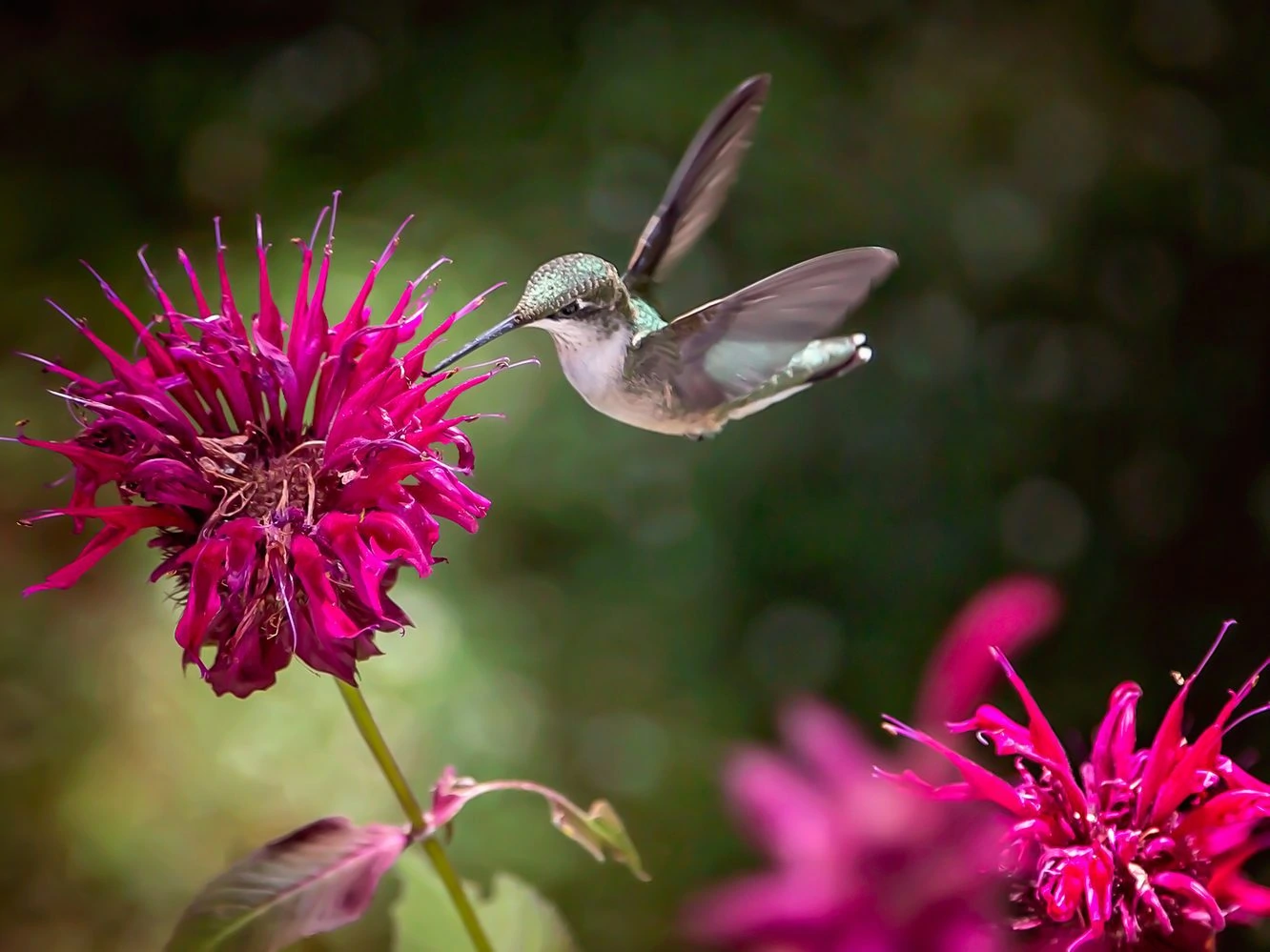
Bee Balm comes from the Monarda mint family, Lamiaceae. It is called “Bee Balm” because Native Americans used it as an antiseptic salve for treating bee stings. Its “Oswego Tea” name is also a result of the Oswego Native Americans brewing its leaves for tea.
Monarda plants are not just popular for their minty aromatic leaves but also for their brightly colored, exotic-looking flowers that are a guaranteed magnet for hummingbirds. Monarda didyma flowers are the scarlet-red variants that are most preferred by hummingbirds. They are bright-red, tubular, and bloom from mid-summer to early fall.
Bee Balm thrives in full sun but will tolerate partial shade when the weather becomes too hot. It prefers moist but well-draining soil, so you may have to water regularly depending on your climate.
Planting Bee Balm in your backyard yields plenty of advantages. You get fragrant, aromatic leaves that you can use for salads or tea. You also get brilliant, colorful, long-blooming flowers that look great in your backyard. Plus, they also attract hummingbirds and other pollinators. You may also use its leaves to create your own essential oils for medicinal purposes.
- Common Name: bergamot, bee balm, horsemint, oswego tea
- Scientific Name: Monarda from the mint family, Lamiaceae
- Growing Zones: 4 – 9
- Sun: Full sun, partial shade
- Soil: Rich, moist, well-draining
- Colors: white, pink, red, purple
- Height: 2 – 4 feet tall
- Spread: 2 – 3 feet wide
- Plant Type: Perennial
38. Coneflower
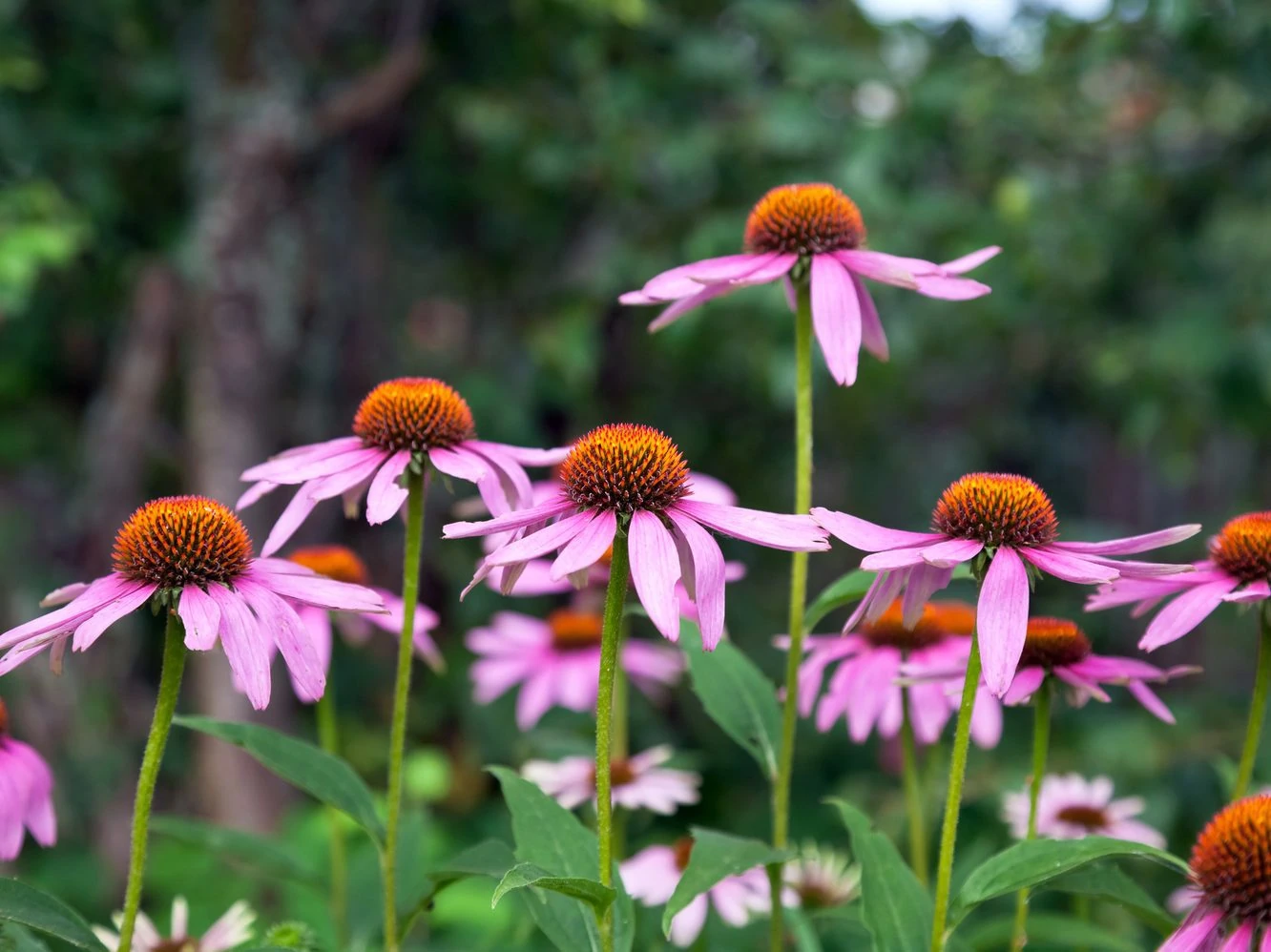
Coneflower is the common name for Echinacea, a genus of flowering plants that belong to the daisy family, Asteraceae. Their scientific name, Echinacea, stands for “sea urchin” in Greek because of their shiny central disk.
There are ten species of coneflowers, named so because their petals tend to point downwards once the central flower head opens, thus forming the shape of a cone. The most common backyard ornamental coneflower is Echinacea purpurea, or the purple coneflower, which is a native of eastern North America.
Coneflowers are large, about 6 inches across, and their stalks reach about 5 feet high. There are other colors available, like pink, red, orange, yellow, and white, depending on the variety. They love being in full sun, like 6 hours daily, and prefer to have well-drained soil. When these conditions are met, you’ll enjoy the flowers from summer to fall.
The brightly colored flowers, particularly the reds and purples, attract hummingbirds and other pollinators like bees and butterflies repeatedly. Their central cone is nectar-rich, and that draws them for a feast.
- Common Name: coneflower
- Scientific Name: Echinacea
- Growing Zones: 3 – 9
- Sun: Full Sun
- Soil: varies
- Colors: white, yellow, orange, pink, red, purple, green
- Height: 2 to 5 feet tall
- Spread: 1 ½ – 2 feet wide
- Plant Type: Perennial
39. Phlox
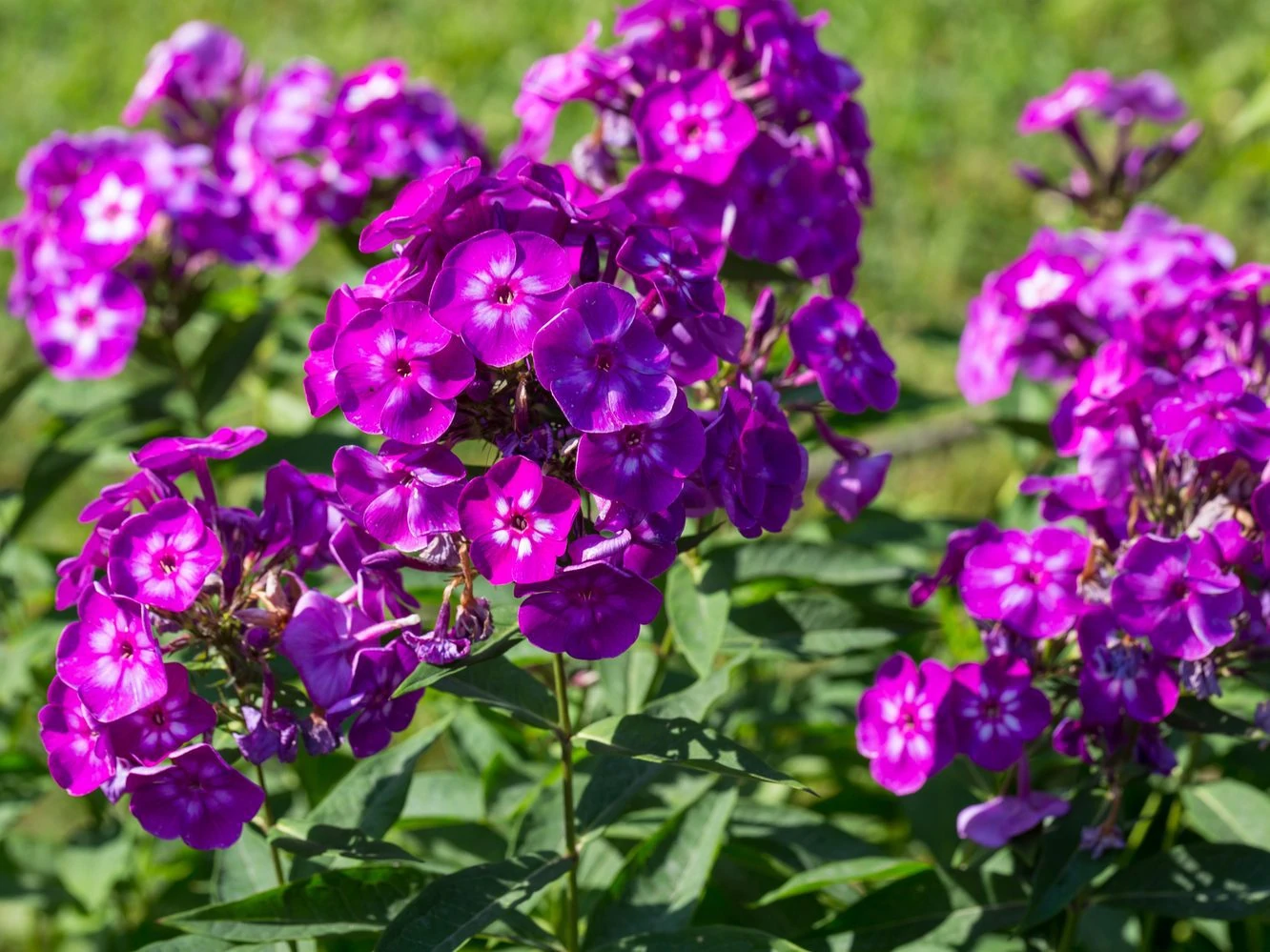
Phlox is a genus of flowering plants whose name is from a Greek word for “Flame” because of its intensely-colored flowers. While there are many varieties, it commonly has three types: Creeping Phlox (Phlox subulata), Woodland Phlox (Phlox stolonifera/divaricata), and Garden Phlox (Phlox paniculata).
Creeping Phlox grow low and wide, close to the ground, which is why they’re perfect as ground covers. Woodland Phlox are of medium height, so they’re usually best for filling gaps. Garden Phlox plants grow tall and erect, so even if they’re at the back, they usually stand out.
Phlox flowers are dainty and grow in clusters of twelve at the top of hardy stems. Most of the flowers are fragrant. Some flower in the spring, others in summer until fall. With many varieties, there are also many colors to choose from, like shades of white, pink, red, purple, and blue.
Since they flower profusely, sometimes it’s hard to appreciate their leaves because you hardly see them. But their leaves are also worthy of your attention. Some are oblong, pointed, and lance-shaped. Some even have border colors, but they’re mostly bright or deep green.
Regardless of their differences, they all attract hummingbirds and other pollinators. Luckily, they’re also easy to grow, and some can spread by self-seeding, so you really have nothing to do except give them the occasional water and let them have a full dose of sunlight.
- Common Name: Garden Phlox, Creeping Phlox, Woodland Phlox
- Scientific Name: Phlox
- Growing Zones: 2 – 9
- Sun: Full sun, part sun, shade
- Soil: Moist, fertile soil with a layer of compost
- Colors: white, pink, red, purple, blue
- Height: 4 to 6 inches, 8 to 12 inches, 2 to 4 feet tall
- Spread: 4 to 6 inches wide, 8 to 12 inches wide, 2 to 3 feet wide
- Plant Type: Perennial
40. Indian Pink
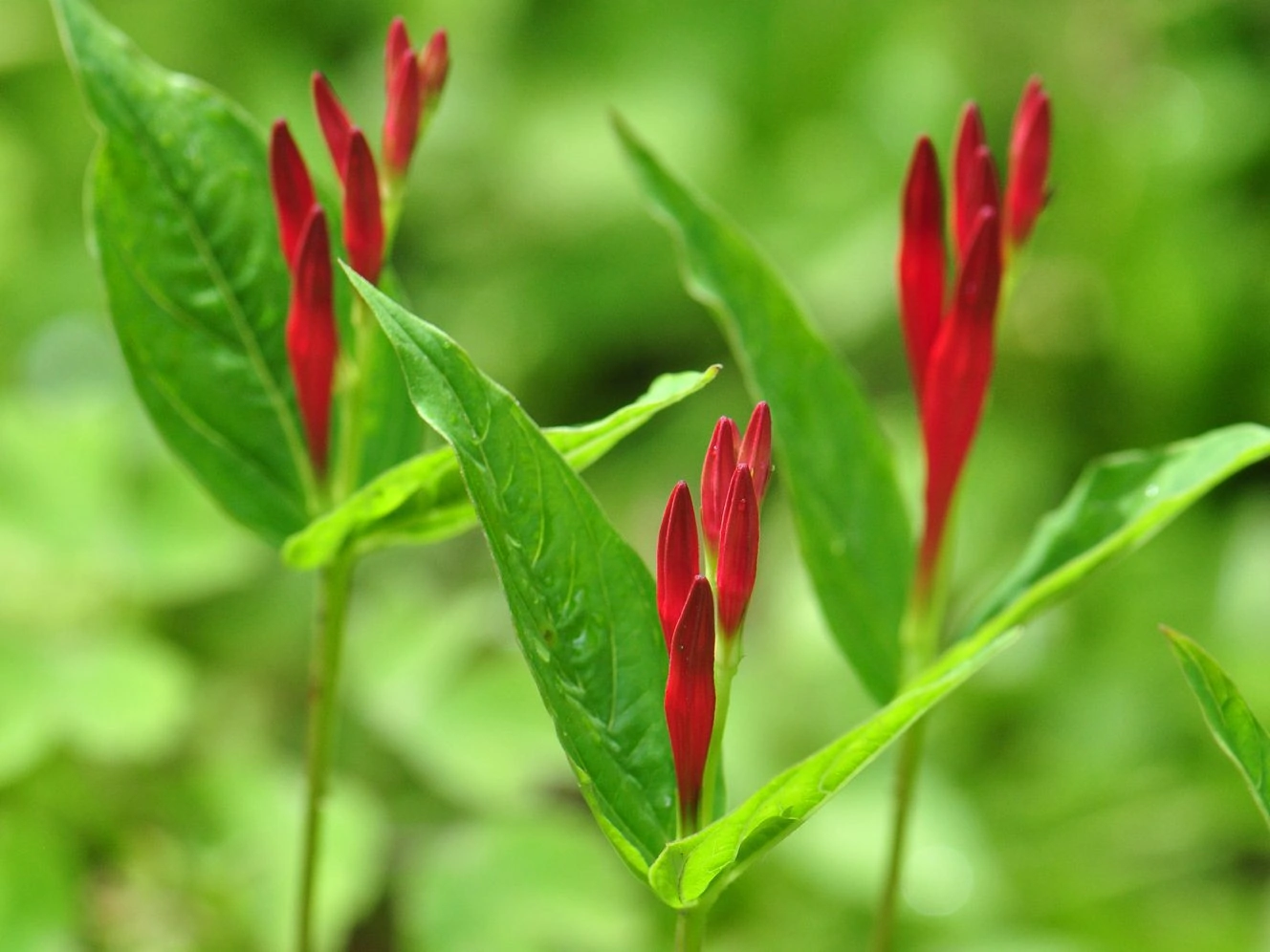
Indian Pink, or Spigelia marilandica, is a herbaceous perennial native to areas in the southeastern United States. It is an uncommon yet attractive plant that is considered threatened in some areas due to indiscriminate harvesting.
Pinkroots, as they are sometimes called, bloom strikingly beautiful flowers from late spring to summer. They are tubular, bright red or burgundy, flowering one at a time from the bottom up, on a single side of a stem. The tip of the flowers opens up to five red petals that curve downward.
When viewed from the top, these flowers resemble a five-pointed bright red star. Each flower is about 2 inches long, and there are about 6 to 12 flowers along the stem. These flowers are a definite magnet for hummingbirds because they’re bright red and they’re tubular.
Once established, you can collect ripe seed capsules in the summer. Indian Pink is easy to grow and is one of the few flowering plants that grow well even in partial shade. 2 to 6 hours of sunlight is enough for them to grow best.
They love good rich, moist soil and can even tolerate a few days of drought. But those that are exposed to more sunlight will do well with regular watering, just avoid too much watering to prevent root rot.
- Common Name: Indian Pink, Pinkroot, woodland pinkroot
- Scientific Name: Spigelia marilandica
- Growing Zones: 5 – 9
- Sun: Partial shade
- Soil: high organic, well-draining
- Colors: red, yellow
- Height: 1 – 2 feet tall
- Spread: 1 – 2 feet wide
- Plant Type: Perennial
41. Fire Pink
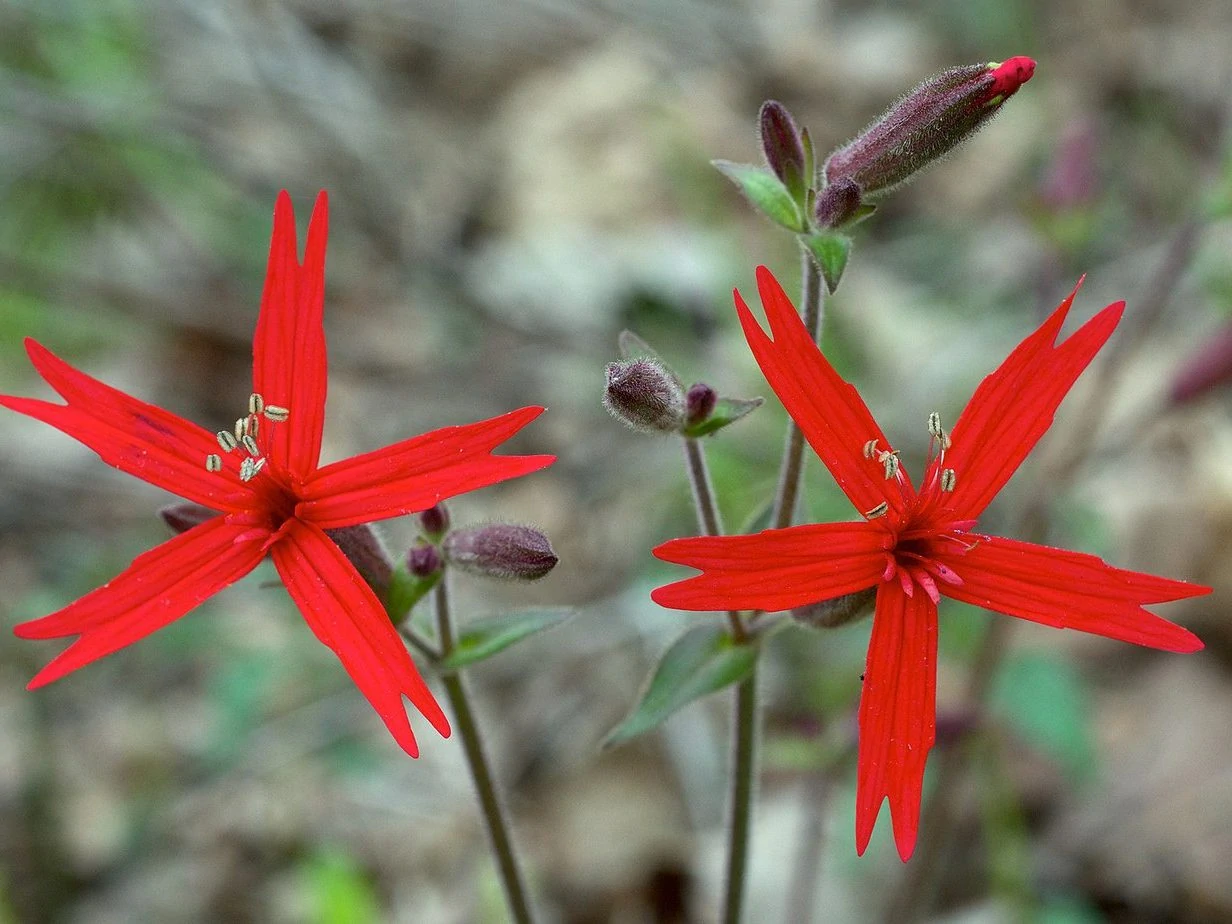
Fire Pink, Silene Virginica, is a wildflower from the pink family, Caryophyllaceae. One species, Silene virginica var. Robusta is endemic to West Virginia, while others are found in eastern North America. It is protected as endangered species in Wisconsin and Florida and as a threatened species in Michigan.
Fire Pink is also known as Scarlet Catchfly because its hairy and sticky stems catch flies and other insects. The sticky residue discourages these insects from eating the plant. They, as well as hummingbirds, are naturally attracted to these Fire Pink plants because of their bright-red, nectar-rich flowers.
There are about 3 to 10 scarlet flowers that grow loosely from the stems. Each flower is five-petaled and deeply notched on the tips. They flower from mid-spring to summer. One of its principal pollinators is the ruby-throated hummingbird (Archilochus colubris).
Fire Pink is best suited to growing in beds and borders. If you want them to self-seed, plant them in prairies and meadows. They thrive in part shade with dry to medium moisture and well-drained soils.
- Common Name: Cliff Pink, Fire Pink, Scarlet Catchfly
- Scientific Name: Silene Virginica
- Growing Zones: 4 – 8
- Sun: Partial Shade
- Soil: dry, moist
- Colors: Red
- Height: 6 inches – 2 feet tall
- Spread: 10 inches to 2 feet wide
- Plant Type: Perennial
42. Butterfly Weed
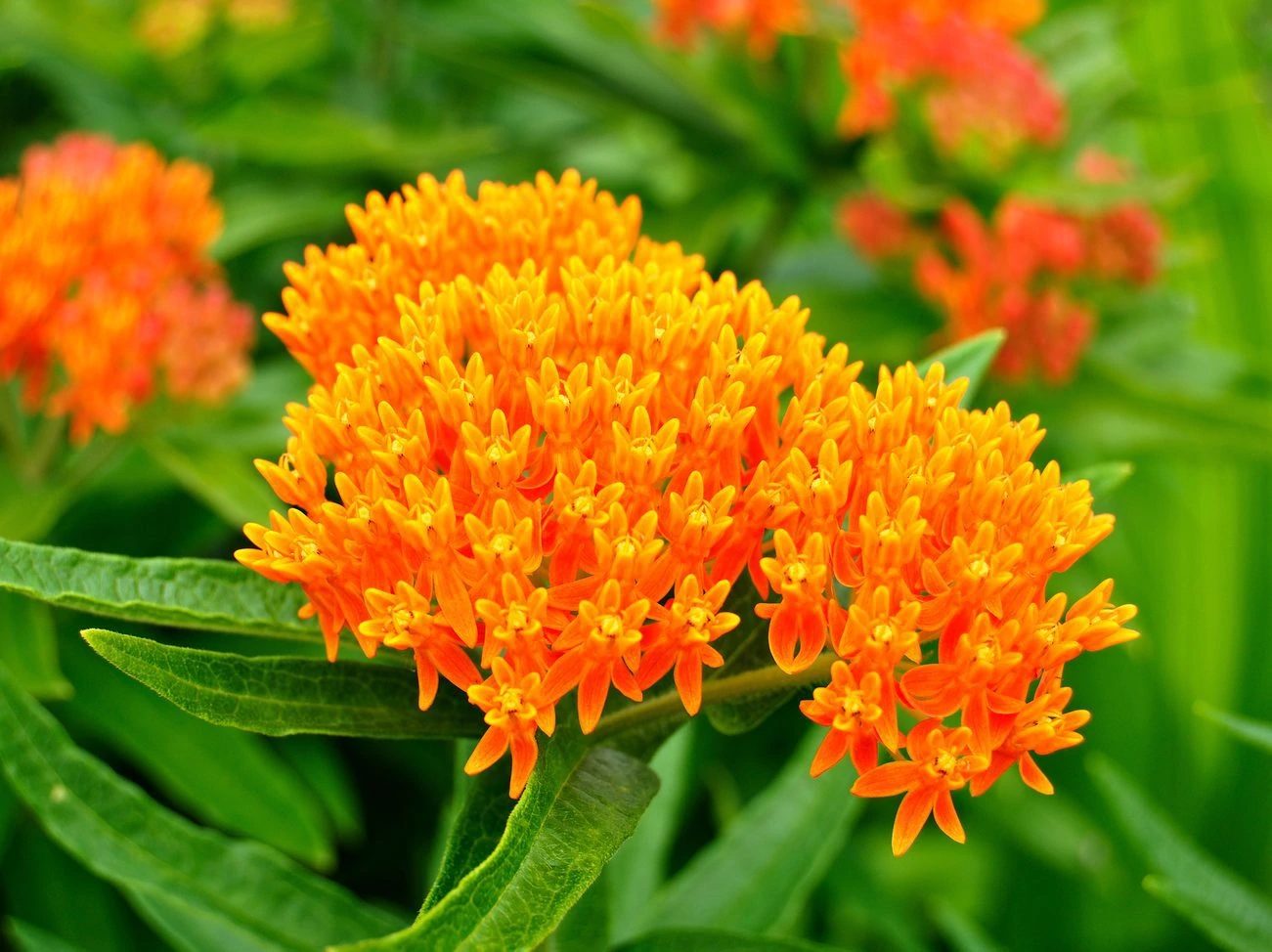
Butterfly weed, Asclepias tuberosa, is a bushy, showy plant that is also known as Pleurisy Root because its tough root was chewed by Indians as medicine for pleurisy and other pulmonary diseases. It is also called Orange Milkweed, as its flowers are orange and it belongs to the Milkweed family, but it doesn’t have a milky sap.
If you want to attract butterflies, bees, and hummingbirds to your garden, you need to plant Butterfly Weed. The orange to yellow, nectar-rich flowers grow in clusters atop thick, hairy stems amid a bright green, lush foliage.
Enjoy the blooms from late spring to summer but be careful to remove their seed pods if you don’t want them to self-seed, as they can be invasive.
Butterfly weed plants are easy to grow, but they take a long time, as long as three years, before you can see them flower. It’s also best to plant them in a permanent place because their roots are tuberous, and they don’t like to be moved. But they thrive in full sunlight and will rarely require regular watering once they’re established.
Planting Butterfly Weed does not only beautify your garden and provides nectar to hummingbirds, bees, and butterflies. It also prevents the extinction of monarch butterflies that rely on the milkweed leaves as food for monarch caterpillars.
- Common Name: Butterfly Flower, Butterfly Weed, Orange Milkweed, Pleurisy Root
- Scientific Name: Asclepias tuberosa
- Growing Zones: 3 – 9
- Sun: Full sun
- Soil: poor, dry, well-drained soil
- Colors: orange, yellow or red
- Height: 1 to 2 feet tall
- Spread: 12 to 18 inches wide
- Plant Type: Perennial
43. Yarrow
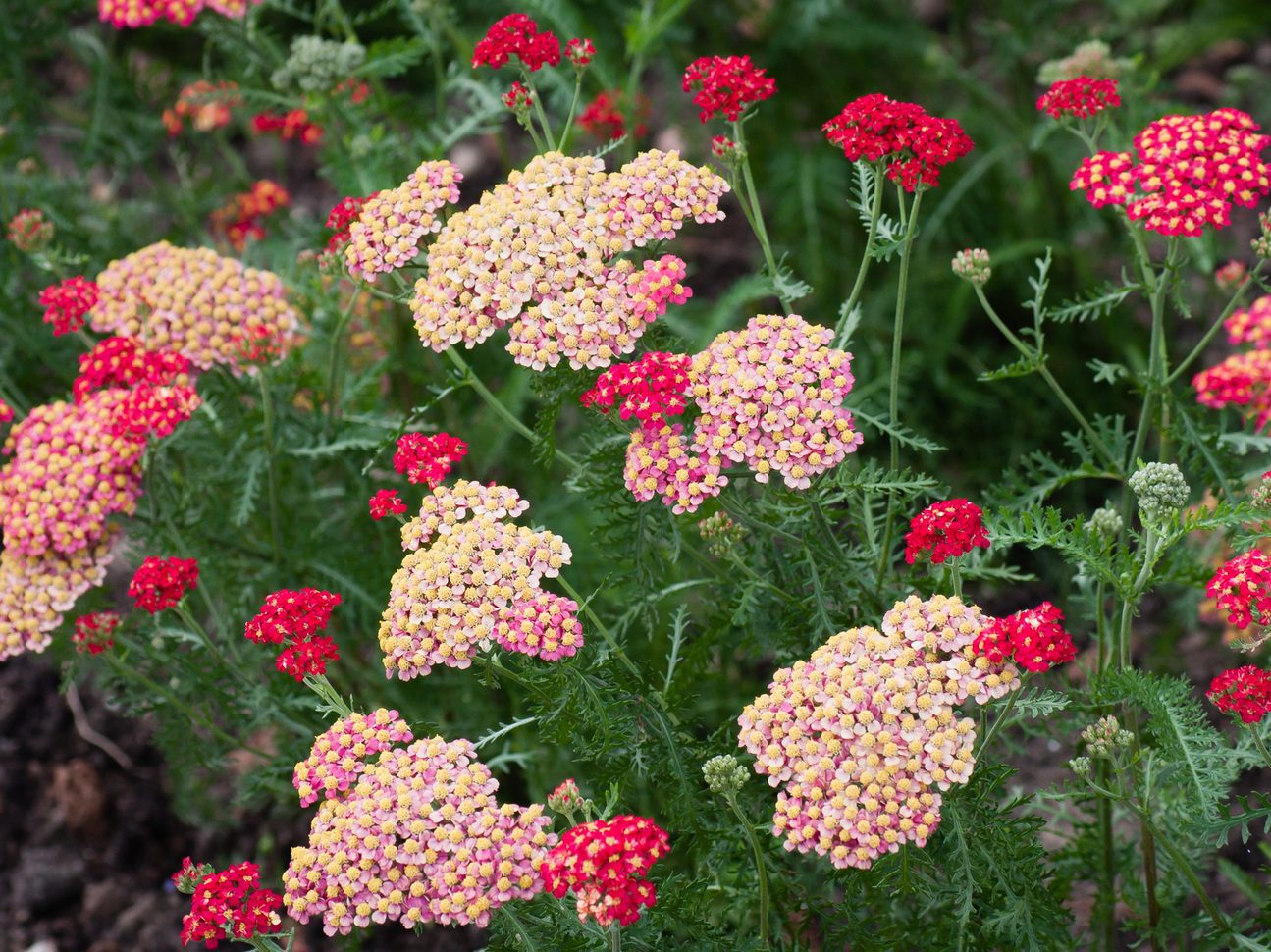
Yarrow, or Achillea millefolium, has a lot of folklore attached to its name. “Achillea” stands for the mythical Greek hero Achilles, who supposedly used yarrow to treat his soldier’s wounds.
It was also known as “Nosebleed” for its use in either starting or stopping nosebleeds. “Millefolium” translated means “thousand leaves,” referring to its feather-like leaves, which appear divided into a thousand leaves.
The Common Yarrow is grown in many backyards because of its attractive clusters of tiny flowers that may be white, yellow, pink, or red, depending on their variant. Flowers on a cluster can range from 15 to 40, growing tightly from their stems.
Their feathery leaves are beautiful to look at as well. They’re evenly distributed along the stem and can be 2 to 8 inches long. The leaves that are near the bottom and the middle are those that grow larger. They are aromatic and have a soft, fern-like appearance.
These lovely yarrow flowers are a major attractor of pollinators like hummingbirds, bees, and butterflies. Cultivating them in your garden is easy if you expose them to full sunlight and give them enough water to keep them hydrated.
Not only will you get beautiful, aromatic flowers, but you can also use the Common Yarrow for a variety of ailments, like wounds and burns, colds, fever, and headaches.
- Common Name: Common Yarrow, Milfoil, Nosebleed, Thousand-leaf
- Scientific Name: Achillea millefolium
- Growing Zones: 3 – 9
- Sun: Full sun
- Soil: sandy, loamy, clay, well-draining
- Colors: white, yellow, pink, red
- Height: 2 to 3 feet tall
- Spread: 2 to 3 feet wide
- Plant Type: Perennial

